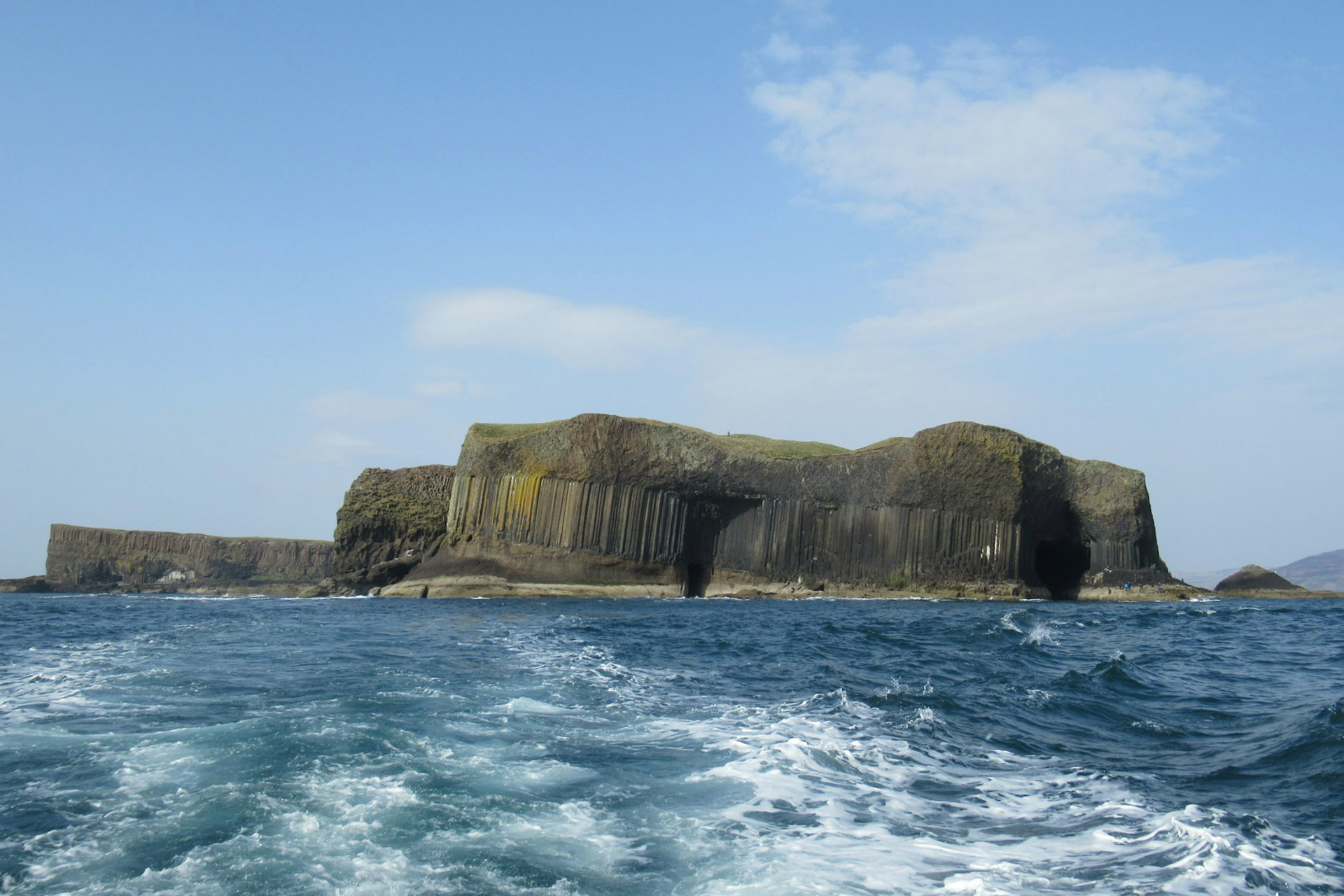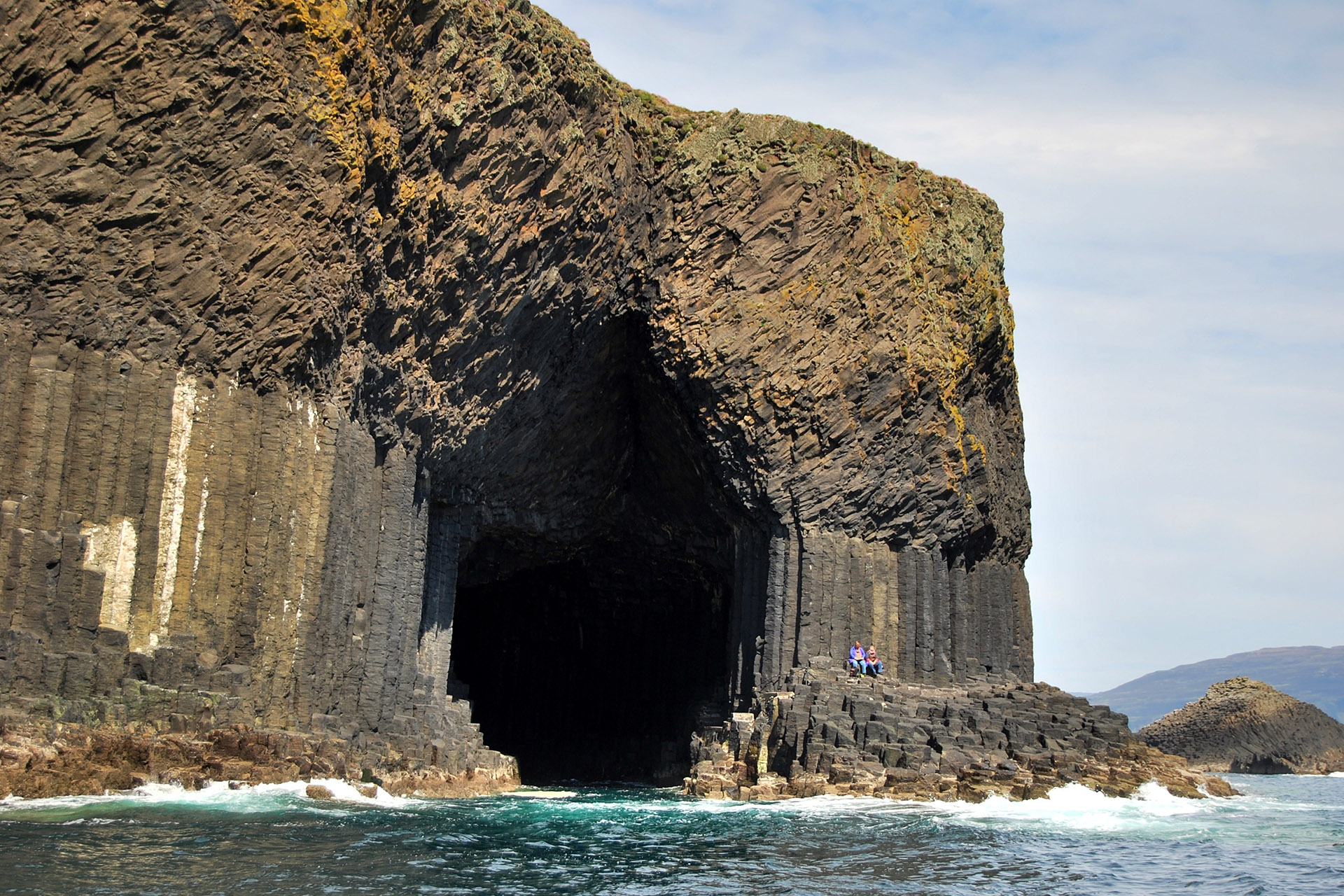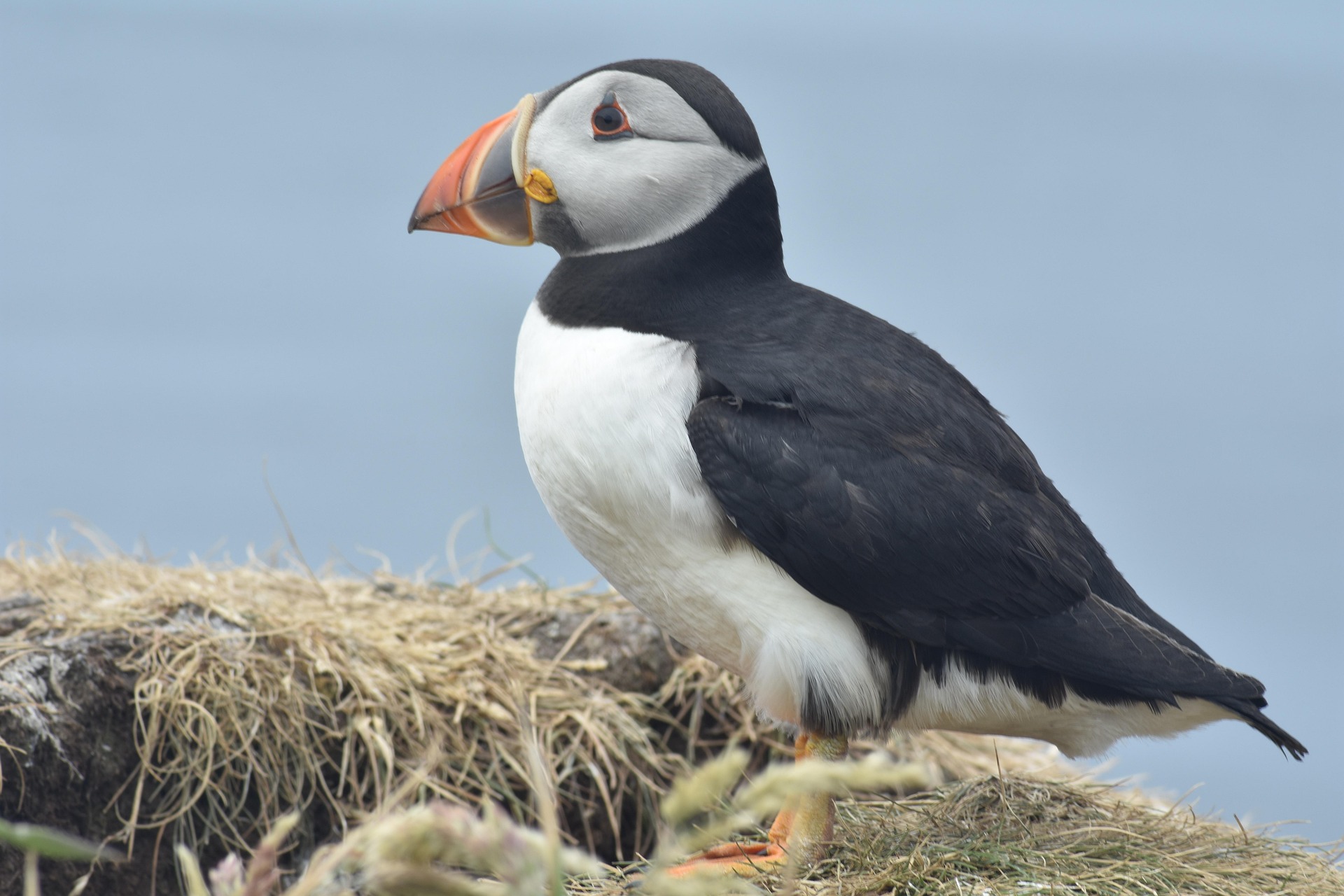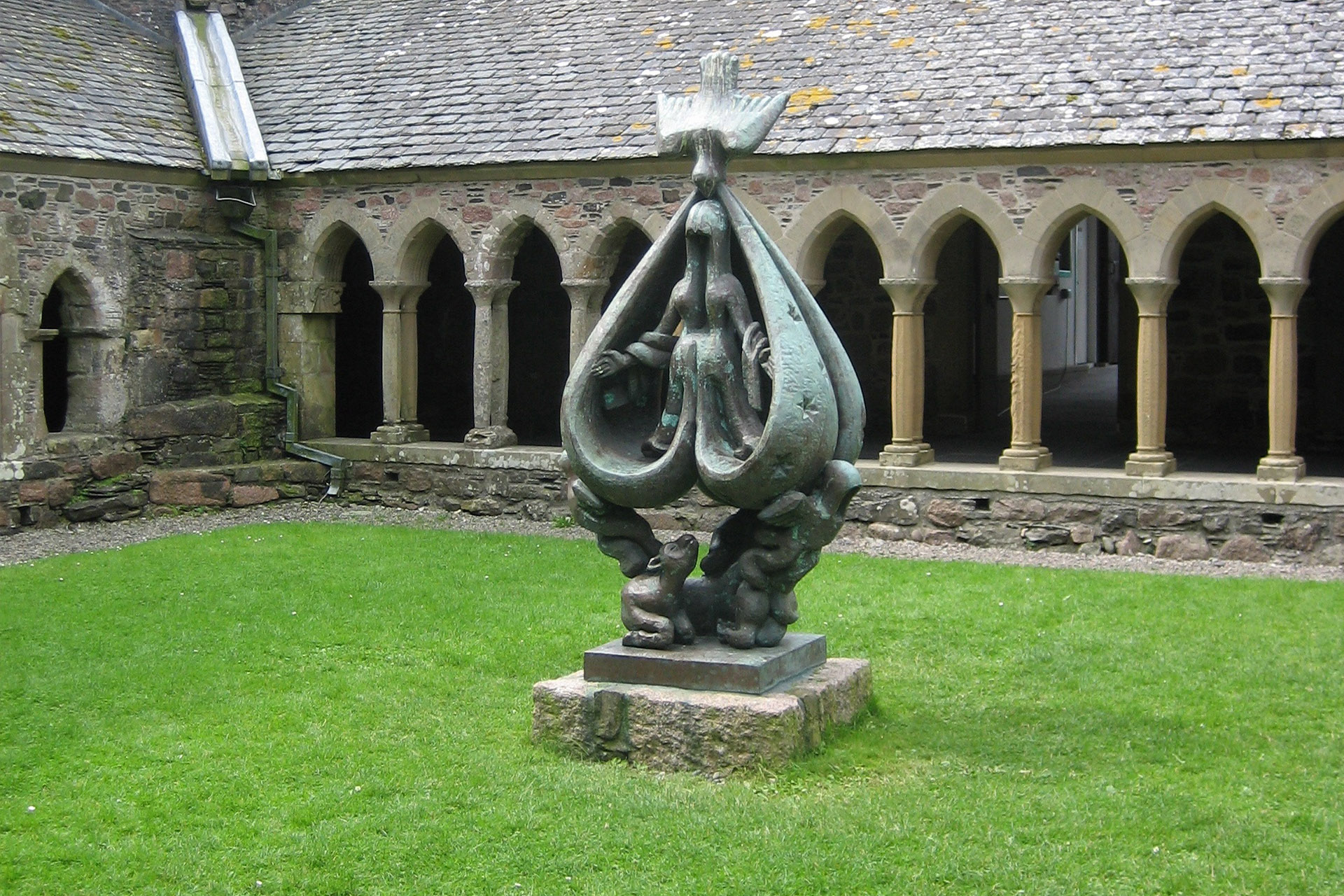Introduction: Discovering the Hebridean Gems
The Inner Hebrides, particularly the enchanting islands of Mull, Iona, and Staffa, beckon with a captivating tapestry of dramatic landscapes, profound history, diverse wildlife, and tranquil charm. From Mull’s rugged mountains and vibrant towns to Iona’s spiritual serenity and Staffa’s unique geological wonders, each island offers a distinct and unforgettable experience. This guide unveils 20 unmissable activities across these remarkable Scottish islands, providing you with all the essential details on locations, costs, and key considerations for planning your adventure in 2025 and beyond.
Isle of Mull: Adventures and Heritage
The Isle of Mull, the second-largest island of the Inner Hebrides, is a hub of natural beauty and historical significance, offering a wide array of activities for every type of explorer.
1. Eas Fors Waterfall: Nature’s Grand Cascade
Eas Fors Waterfall, a truly spectacular natural feature on Mull, is located just off the B8073, a few miles north of Ulva Ferry. A small parking area is available before the bridge, providing convenient access for visitors. The waterfall offers captivating views across Loch Tuath towards the Isle of Ulva.
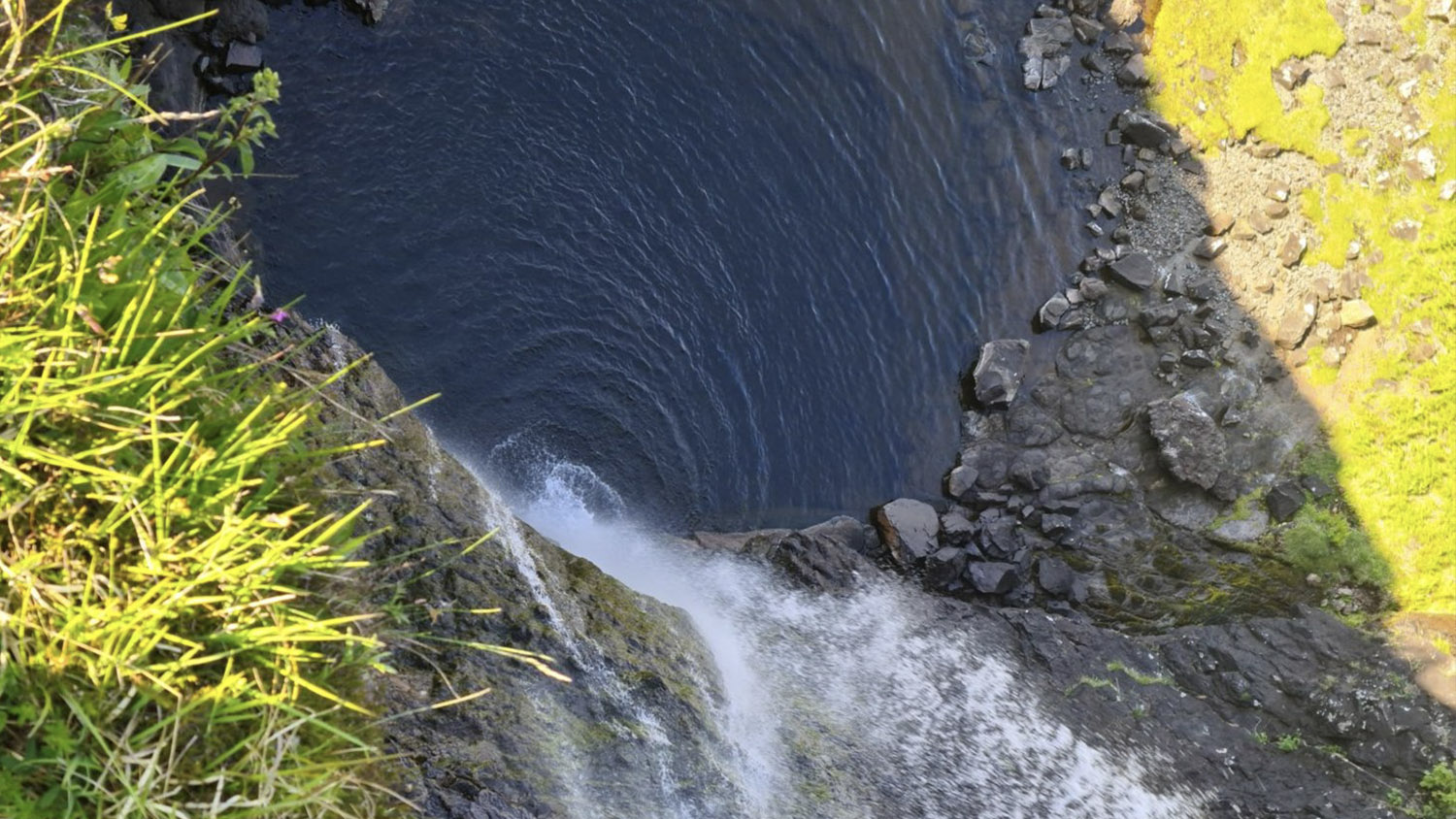
The name “Eas Fors” itself is a curious linguistic redundancy, as both “eas” (Gaelic) and “fors” (Norse) mean “waterfall,” effectively translating to “waterfall waterfall.” This tautological naming is a common occurrence when terms from different languages are merged. The waterfall comprises a series of three distinct falls: the Upper Falls, situated above the road with a designated safe viewing point; the Middle Falls, located just below the road, featuring a picturesque pool that might seem ideal for a picnic; and the final, Lower Falls, which dramatically plunge 100 feet over a cliff directly into the sea below.
Access to Eas Fors is free of charge. However, it is imperative that visitors approach this natural attraction with extreme caution. The area around the Middle Falls is inherently dangerous, particularly for young children, as there are no protective barriers, and the grassy ground can be exceptionally slippery. A critical safety advisory warns against leaning over the edge to view the dramatic drop. For the most impressive and safest view of the Lower Falls, it is recommended to walk approximately half a mile down the road towards Ulva Ferry and then follow a track along the stony beach. This short, half-hour walk provides the most dramatic and secure vantage point, transforming the experience from a simple roadside stop into a rewarding mini-hike that prioritizes visitor well-being. The unmanaged nature of this environment necessitates a high degree of personal responsibility and adherence to safety guidelines.
2. Calgary Bay Beach: White Sands and Coastal Charm
Calgary Bay Beach, nestled in a deep bay on Mull’s west coast, is widely recognized as the island’s most famous and arguably finest beach. Its distinctive white shell sand and clear, turquoise waters evoke comparisons to a tropical paradise, although the refreshing chill of the Scottish sea quickly dispels such illusions upon dipping one’s toes. The name “Calgary” translates to “Bay of the meadow,” a reference to the expansive machair—a unique habitat of flower-rich, sandy, calcium-rich soil—that lies behind the beach.
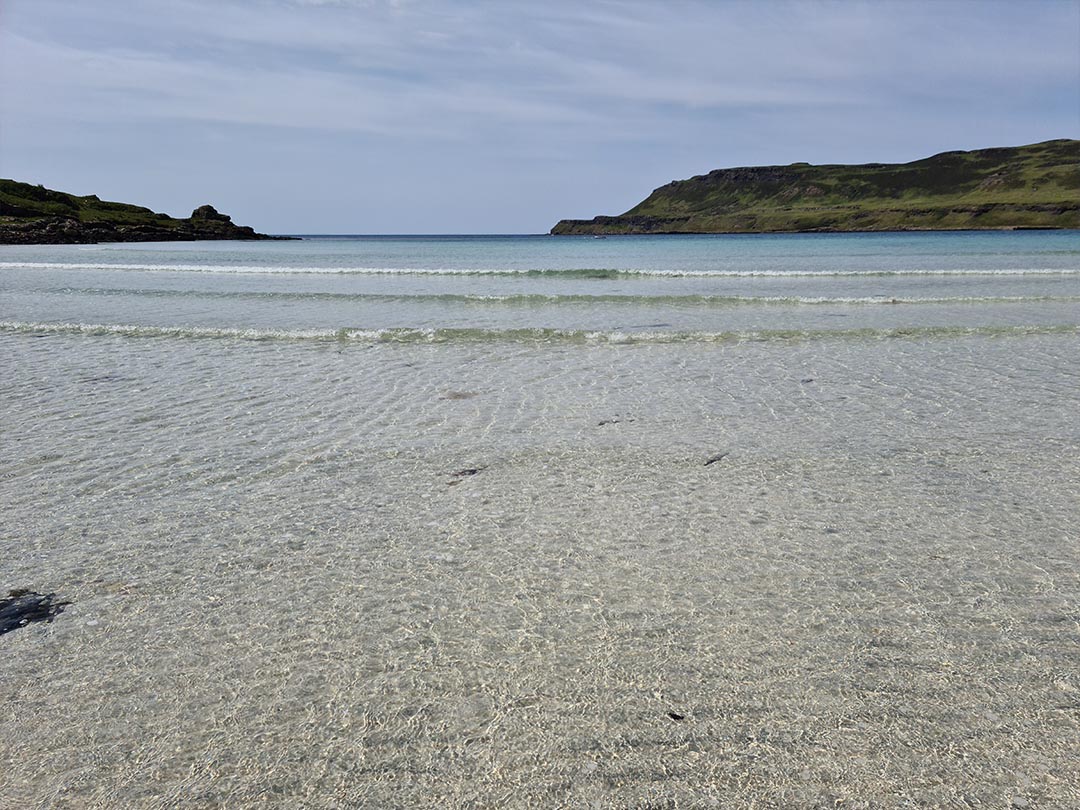
Access to Calgary Bay Beach is free. The bay’s sheltered nature makes it an excellent location for swimming and leisurely walks. For those wishing to extend their stay, camping is permitted for tents and small vehicles at the southern end of the bay, though it is generally not encouraged in other areas. Toilet facilities, recently renovated by local community efforts, are conveniently located near the camping area. Visitors are kindly requested to maintain their cleanliness and respect these amenities. It is an important point of local infrastructure that these toilets are not equipped to handle waste from mobile homes; dedicated facilities for such waste are only available at official campsites. This specific limitation underscores the need for responsible tourism practices, particularly concerning waste management by mobile home users, which is essential for preserving the beach’s pristine environment and respecting the community’s efforts to maintain it. During the summer months, a local family operates a small ice-cream stall, and a cafe is situated uphill at Calgary Farmhouse, offering refreshments. The area also provides opportunities for exploration, including a walking trail that leads to geological points of interest and an abandoned village named Inevea. The beach is also welcoming to dogs.
Beyond its natural allure, Calgary Bay holds a unique historical connection. Calgary Castle, which overlooks the bay, is reputed to be the namesake of the Canadian city of Calgary. The story recounts that in 1876, Colonel James McLeod of the Canadian Mounties, having fallen in love with the owner’s daughter, subsequently renamed Fort Brisebois in Alberta to Fort Calgary upon his return to Canada. This anecdote adds a fascinating layer of cultural and historical interest, enriching the visitor’s understanding of the location beyond its scenic beauty.
3. Wildlife Watching on Mull: Land-Based Encounters
Mull stands as a premier destination for land-based wildlife observation, offering unparalleled opportunities to encounter Scotland’s iconic species in their natural habitats. Various tour operators specialize in guiding visitors through the island’s rich ecosystems.
Mull Magic Wildlife Walks and Tours, established in 2005, provides guided excursions that delve into Mull’s abundant wildlife, local history, and folklore. They offer a convenient “door to door service” for most walks, with ferry collection available for some. The experience is enhanced by a renowned homemade lunch and tea with scones. Mull Magic’s diverse offerings include specialized “Otter Walks” and “Eagle Walks,” with a total of nine different routes ranging in difficulty from easy rambles to more strenuous “Mountain Walks”. They also cater to individual preferences by offering bespoke and private guided walks across Mull, Iona, and Ulva.
Nature Scotland conducts land-based wildlife adventures that explore the Isle of Mull and the Ardnamurchan Peninsula. Their tours focus on seeking out species such as Golden Eagles, White-Tailed Eagles, Otters, Hen Harriers, and Red Deer. The “Mull Nature Explorer,” their flagship tour, is vehicle-based and incorporates easy, leisurely walks of 30-60 minutes to allow deeper immersion in the island’s wilder areas. Other options include the “Mull Wilderness Explorer” (walking-based), the “Ardnamurchan Tour,” and customized “Private Tours”.
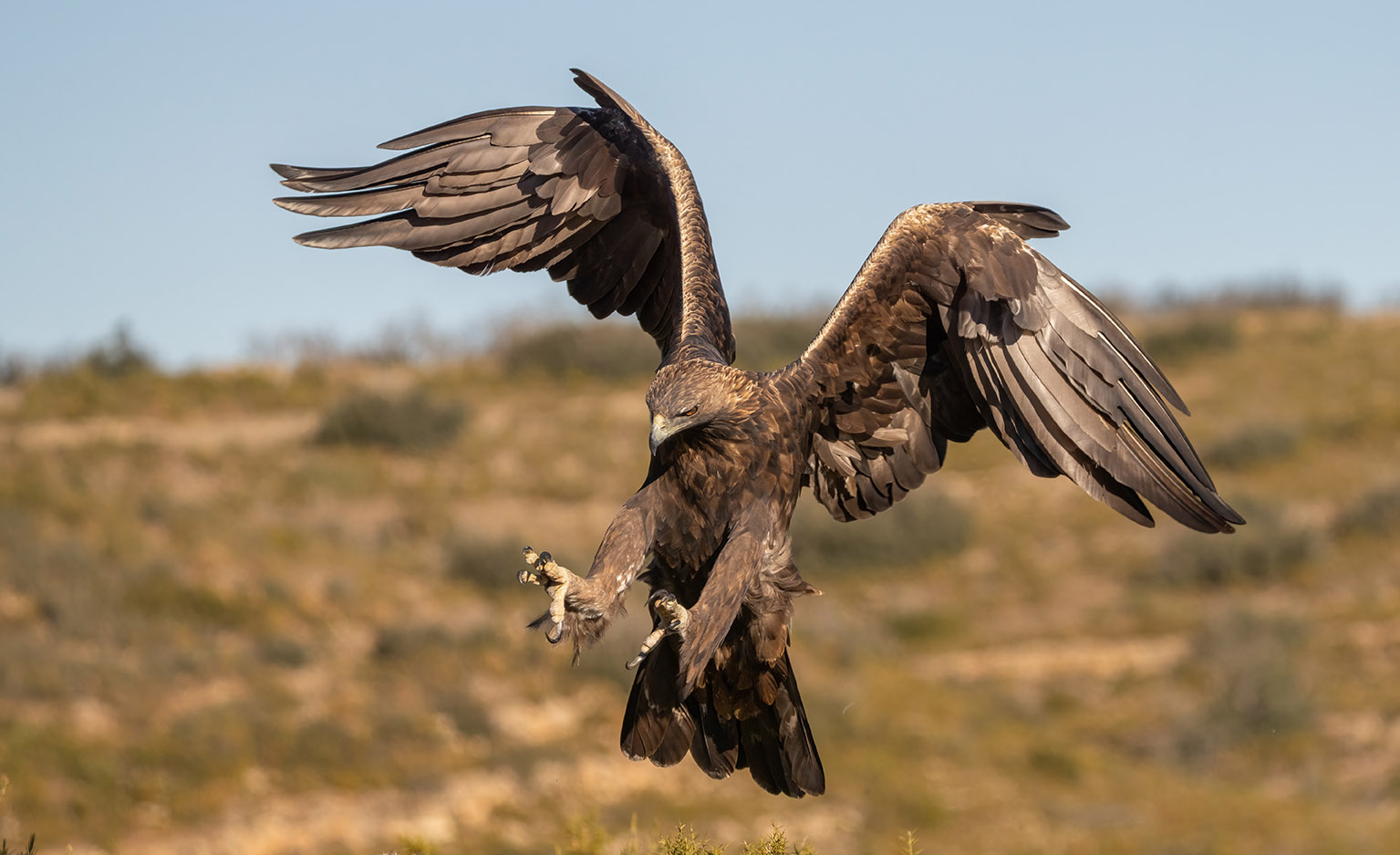
Specific viewing opportunities abound across Mull. Both Golden and White-tailed Eagles are regularly sighted. The “Mull Eagle Watch and Hide” program provides safe, distant viewing of nesting White-tailed Eagle families from three designated sites: Craignure golf course, Dervaig, and Tiroran forest. Otters are frequently encountered, with Mull Magic offering dedicated walks focused on observing these elusive creatures. Red Deer are a common sight across the island’s varied landscapes, and Hen Harriers are also a target species on Nature Scotland tours.
While independent wildlife watching is possible, engaging with guided tours significantly enhances the visitor’s chances of spotting specific animals and provides a more profound understanding of the local ecosystem. The presence of passionate and knowledgeable local wildlife guides, who share information about the diverse species, responsible viewing practices, and local history and folklore, transforms a simple observation into an educational and immersive experience. For instance, a “Guided Wildlife Watch at Glengorm Castle,” which is a land-based tour on the estate, costs approximately $20-$21 per person. Specific pricing for Mull Magic and Nature Scotland tours should be confirmed directly with the operators.
It is important for all visitors to practice ethical tourism and minimize disturbance to wildlife. The use of drones, for example, can be disruptive to both other hikers seeking peace and solitude, and to the wildlife itself, particularly near nesting sites. Adhering to principles of minimal impact and respecting the natural environment is crucial, especially given the presence of sensitive species like eagles and otters.
4. Ben More: Conquering Mull’s Only Munro
Ben More, standing at 3,169 feet (966 meters), is the sole Munro (a Scottish mountain over 3,000 feet) on the Isle of Mull. This volcanic mountain presents a challenging yet rewarding hiking experience.
The most accessible route for ascending Ben More begins by following the B8035 from Salen. Parking is available at Dhiseig, on the shores of Loch Na Keal, where a grassy area between the road and the shore offers a safe place to leave vehicles. The hike itself is graded as “Hard” and covers a distance of 6 miles. The estimated time for the round trip is approximately 300 minutes, or 5 hours. It is crucial to note that while some sources suggest 2 to 3 hours to reach the summit, this typically refers to the ascent time only, making the 5-hour estimate a more realistic duration for the complete round trip and emphasizing the significant time and physical commitment required. The terrain is characterized by a very rough track, with rocky and steep sections, rendering it unsuitable for novices and recommended only for experienced hill climbers.
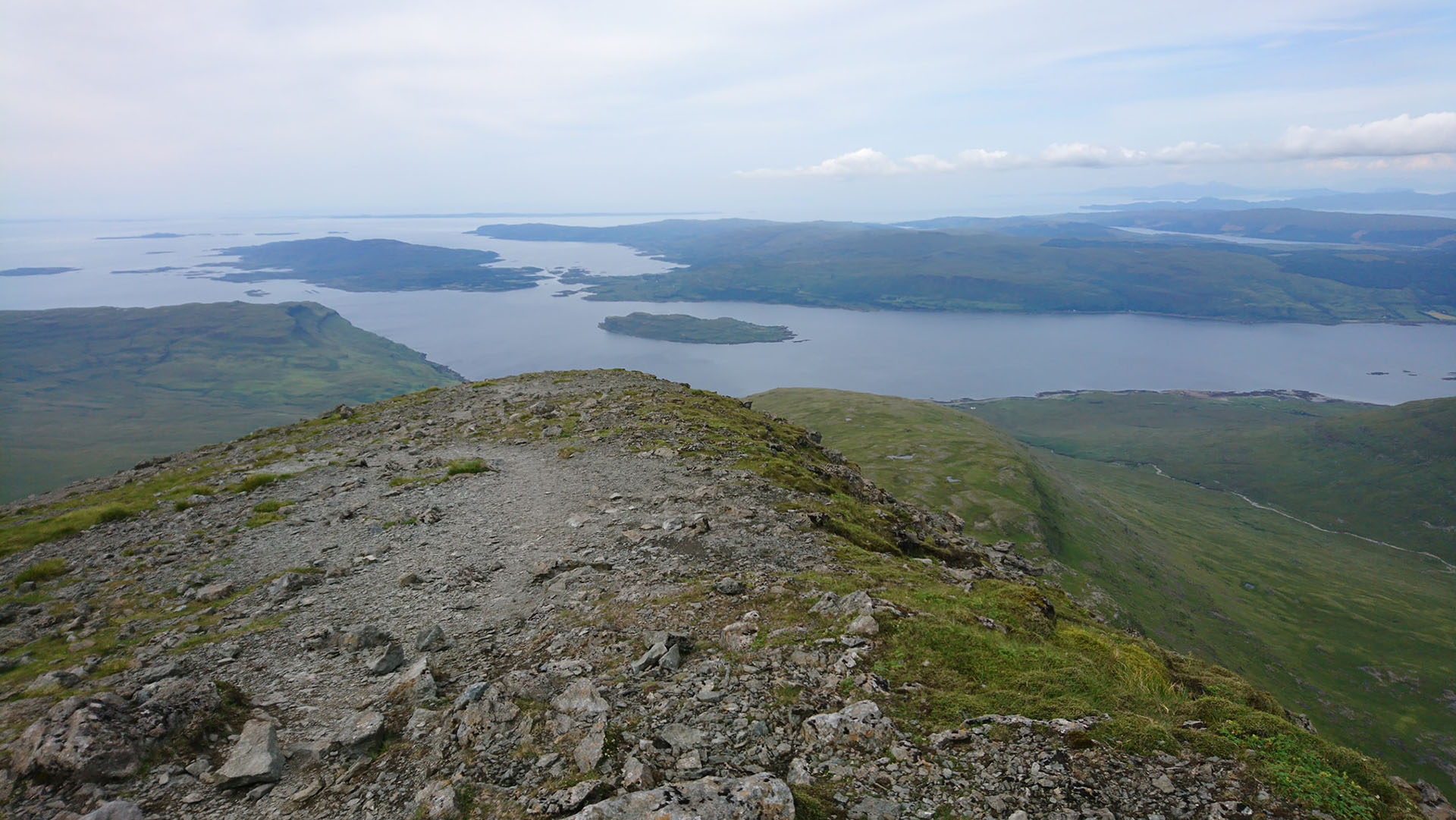
Ben More from the summit.
The path ascends past a farmhouse and follows the course of the Abhainn Dhiseig burn. After crossing the burn, there is a particularly steep ascent onto the summit ridge, from which a wider track leads directly to the summit cairn. From the summit, on clear days, hikers can be rewarded with expansive panoramic views that may include Ireland, the Outer Hebrides, and even Ben Nevis. The return journey follows the same route.
Hiking Ben More independently is free of charge. However, for those seeking guidance or a more structured experience, Mull Magic offers guided walks, with pricing available upon direct inquiry. A unique challenge posed by Ben More is its volcanic nature, which can cause compasses to be unreliable and make accurate readings impossible. This navigational difficulty, coupled with the demanding terrain, strongly suggests that hikers, particularly those unfamiliar with the area or advanced navigation techniques, should consider joining a guided walk or undertaking the ascent with a more experienced companion. This approach not only enhances safety but also leverages local expertise for a more informed and secure experience.
5. Duart Castle: A Clan Maclean Stronghold
Duart Castle, a formidable 14th-century fortress, stands proudly on the Isle of Mull, serving as the ancestral home of the Clan Maclean. Overlooking the sea, the castle offers breathtaking views of the surrounding landscape. While it was restored in the early 20th century, many of its original features were retained or updated, preserving its historic character.
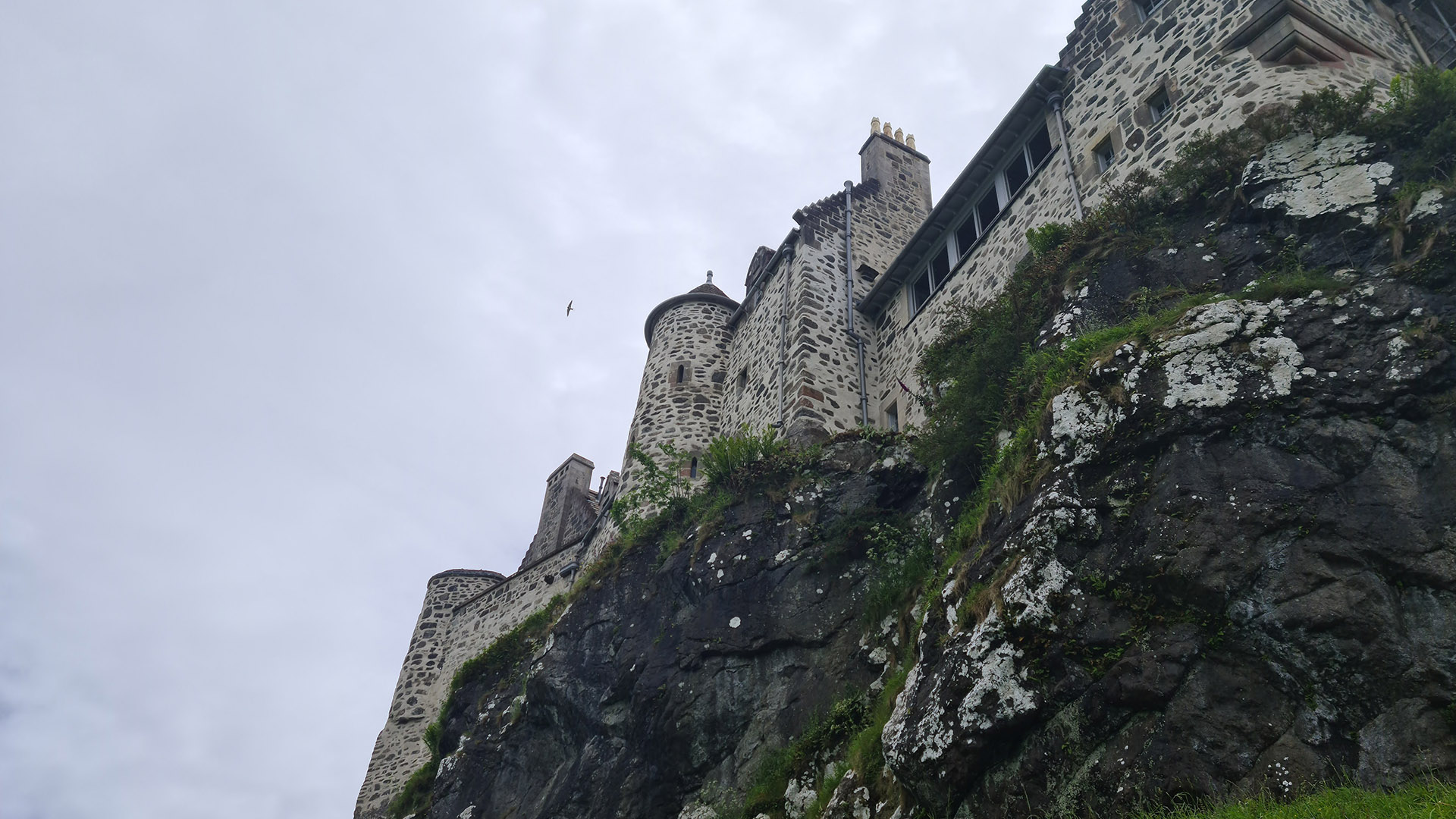
Duart Castle from below
Admission Prices (2025-2026):
Entry to Duart Castle itself requires a ticket, which can be purchased upon arrival or online. Online booking is generally recommended, especially for carers accompanying visitors with disabilities to guarantee entry.
| Ticket Type | Online Price | Walk-up Price |
|---|---|---|
| Adult (16-64yrs) | £10.00 | £11.00 |
| Concession (65yrs+ & unemployed) | £8.00 | £9.00 |
| Child (7-15yrs) | £6.00 | £6.50 |
| Family (1 adult, 2 children) | £20.00 | £21.50 |
| Family (2 adults, 2 children) | £29.00 | £31.50 |
| Family (2 adults, 3 children) | £34.00 | £37.50 |
Note: Children under 16 must be accompanied by an adult. Concession prices require valid proof. Historic Scotland members receive free entry, and English Heritage, Manx, and Cadw members receive half-price or free entry depending on membership status. Young Scot cardholders pay £1.
Opening Times (2025):
The castle’s operating season runs from April 1st to October 18th.
- April: From April 1st to April 30th, the castle will be open six days a week, from 10:30 AM to 4:00 PM. It will be closed on Thursdays, with the exception of Thursday, April 24th, when it will be open due to popular demand.
- May to September: From May 1st to September 30th, the castle will be open seven days a week, from 10:30 AM to 5:00 PM.
- October: From October 1st to October 18th, the castle will be open six days a week, from 10:30 AM to 4:00 PM, and will be closed on Thursdays.
Even outside these hours, the castle grounds remain accessible for visitors to view the exterior and enjoy the sea views, with a donation box available near the car park.
Facilities and Accessibility:
- The Castle Grounds, Tearoom, and Gift Shop are freely accessible to all visitors.
- Dogs are permitted in the castle grounds but are not allowed inside the castle building, tearoom, or shop, with the exception of assistance dogs.

Given its origins as a 14th-century defensive fortress, Duart Castle was not designed with modern accessibility in mind. The interior features spiral stairs to most floors and narrow corridors, with only one designated route from the first floor to the top and back down. While a detailed Disability Access Statement is available to guide visitors with mobility considerations, it is important to understand that “accessible” in this context refers to the provision of information and some accommodations rather than full barrier-free access. Visitors with mobility issues are strongly advised to consult this detailed statement or contact the castle directly to assess the suitability of the visit for their specific needs.
The tearoom and shop are housed in a separate old farm building. Toilets are located in the same building, with access either via a level outside door or through the restaurant, which involves steps. The car park and most walkways leading to the castle, shop, and tearoom have a loose slate or shingle surface that can be uneven. Two wide disabled parking spaces are available near the pedestrian access, and visitors unable to walk the distance can arrange to drive closer to the buildings by prior arrangement.
A significant logistical point for travelers is the lack of public transport directly to Duart Castle from the Craignure Ferry Terminal. The castle is a 3-mile walk from Craignure. Therefore, visitors arriving by ferry without private transport should plan to arrange a taxi service in advance or be prepared for a considerable walk, which will impact their overall itinerary and time management for the day.
6. Take a Day Trip to the Isle of Ulva
The Isle of Ulva, a small, car-free island situated off the west coast of Mull, offers visitors a unique journey back in time, rich in natural beauty, diverse wildlife, and profound historical narratives, including remnants of 19th-century clearances and Mesolithic archaeological finds.
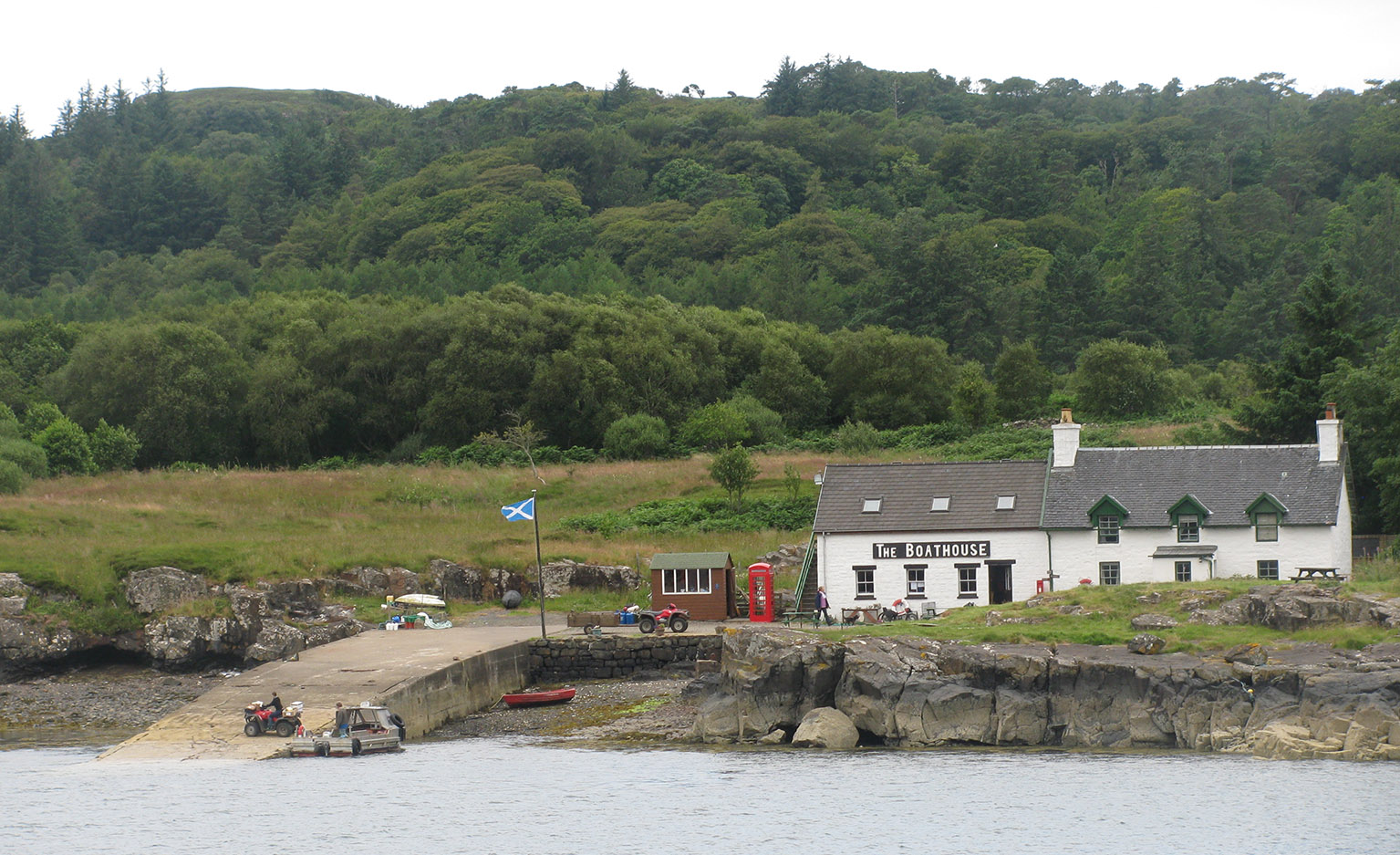
By Zenit – Own work, CC BY-SA 3.0, Link
Ferry Access and Cost:
Ulva is accessed via a privately run foot passenger ferry from Ulva Ferry on Mull.
- Operating Hours: The ferry operates Monday through Friday from 9:00 AM to 5:30 PM (on demand), from April 1st until October 25th. Additionally, it runs on Sundays during June, July, and August. It is crucial to note that the ferry never operates on Saturdays. The “on demand” nature of the service implies that visitors might experience waiting times, reflecting the island’s remote and less commercialized character.
- Fares: Adult tickets cost £8, children £4, and bicycles £2. Well-behaved dogs are permitted to travel free of charge.
- Getting to Ulva Ferry (on Mull): The drive from the Craignure ferry terminal on Mull to Ulva Ferry takes approximately 45 minutes. The final nine miles are along a scenic single-track road, so visitors should allow ample time, especially during busy periods. Public bus service is available from Craignure to Salen, from where the Ulva Ferry Community Transport can be booked, though advance booking is highly recommended, particularly during high season.
Visitor Information:
Vehicles are not permitted on Ulva, so visitors must leave their cars on Mull. Daytime parking is available at Ulva Ferry, with recent upgrades and some hook-up points. For those arriving by boat, an 8-berth pontoon at Ulva Ferry is equipped with power, water, red diesel, and WiFi. Kayaks and small boats can be launched from the Ulva Ferry slipway, but it is advised to avoid times when fishing boats are loading or unloading.
Things to Do on Ulva:
- Dining: The Boathouse Restaurant offers local seafood, such as crab and prawns, alongside homemade bread and other dishes.
- Gardens & Historical Sites: Visitors can explore Ulva’s Walled Garden, which has been undergoing renovation since July 2018. Sheila’s Cottage, an 18th-century thatched cottage that provides interpretive materials on Ulva’s history, was closed for renovation and re-thatching as of summer 2024. This dynamic status of attractions means that visitors should check current conditions before their trip to manage expectations and avoid disappointment, reflecting the island’s ongoing efforts in preservation and development.
- Nature & Scenery: Ulva is a vital habitat for a variety of wildlife, including nesting White-tailed Sea Eagles, Golden Eagles, Hen Harriers, otters, and seals. It is also home to the rare Scotch Burnet Moth. The island’s landscapes are strikingly contrasted, from rugged southern shores dotted with ruined blackhouses (remnants of 19th-century clearances) to extensive mature broadleaf woodlands on the eastern side. The stunning coastline features unique geology, hidden coves, beaches, and lagoons.
- Activities: Exploring the coast by kayak or small boat is possible, but this should only be undertaken by experienced individuals who are fully aware of current conditions, as the seas can be dangerous and conditions change rapidly, with limited places for shelter.
The critical implications of the ferry schedule, particularly the absence of Saturday service and the “on demand” operation, necessitate meticulous planning for any visit to Ulva. This highlights the island’s commitment to preserving its unique, tranquil character by limiting constant public access.
7. Discover MacCulloch’s Fossil Tree: Ancient Wonders on the Coast
MacCulloch’s Fossil Tree is a remarkable geological phenomenon located at the western tip of the Ardmeanach peninsula on the Isle of Mull. This ancient wonder is a conifer tree, specifically cupressinoxylon, a species related to modern Cypress trees. Standing impressively over 12 meters (approximately 40 feet) high and one meter (approximately 3 feet) in diameter, the fossilized tree is found vertically embedded within a cliff face, strikingly surrounded by hexagonal basalt columns. Its formation dates back approximately 60 million years, when volcanic lava slowly flowed across the landscape, encountering the tree within a vast forest. The tree was incinerated and its carbonized remains were then entombed within the rapidly cooling lava, resulting in its unique preservation. The fossil was discovered by geologist John MacCulloch in either 1811 or 1819.
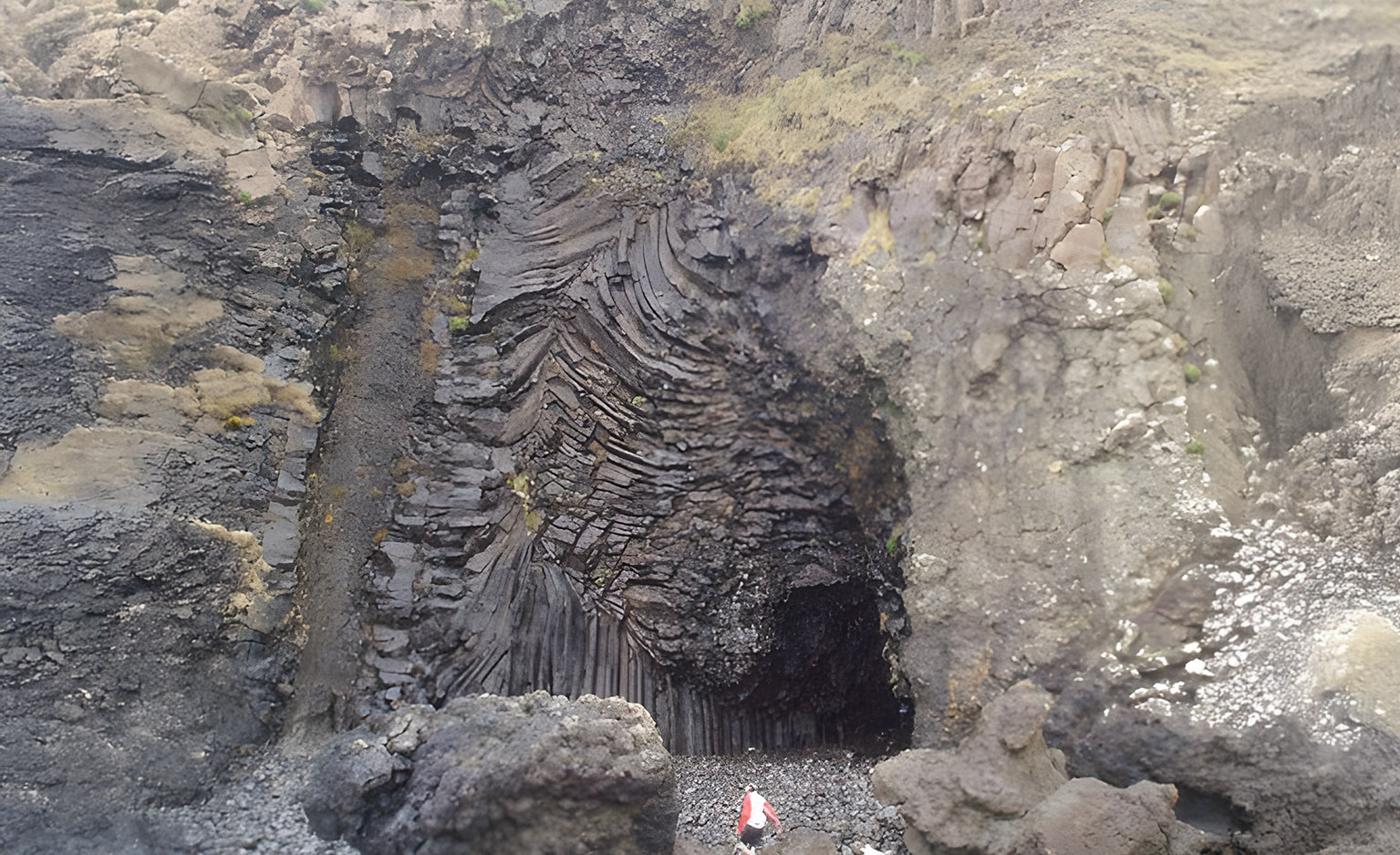
Adam Ward / First Foot, Fossil Tree
Access to MacCulloch’s Fossil Tree is free, however, the journey to reach it is far from a casual stroll and is explicitly described as “certainly not for the faint-hearted”. The trek begins with parking at Tioran. From there, it involves a 6-kilometer (approximately 3.7 miles) cycle to the township of Burgh along Loch Scridain. Following this, a further 3-kilometer (approximately 1.9 miles) walk along the coastline is required. This coastal path includes a challenging rock step equipped with a fixed, albeit rusty, ladder. Relying on the ancient anchor bolts of this ladder, which are exposed to the full force of North Atlantic gales, can be “quite worrying”.
The significant physical demands and potential dangers of the access route mean that visitors must be well-prepared, physically capable, and aware of the risks involved. While some visitors have found the fossil tree itself to be somewhat of an “anti-climax” visually, describing it as “not that photogenic,” the surrounding area offers much to appreciate, including extensive columnar basalt formations along the cliffs and the potential to discover other fossilized trees. The unique geological significance of the site and the challenging journey contribute to the overall experience, making it a destination for those seeking adventure and a deep connection with ancient natural history.
8. Visit Mull Museum: A Glimpse into Island History
The Mull Museum, located in Tobermory, serves as a vital repository of the Isle of Mull’s rich history. Despite its modest size, the museum is “crammed with information about Mull in the past,” offering a comprehensive look into various facets of island life.
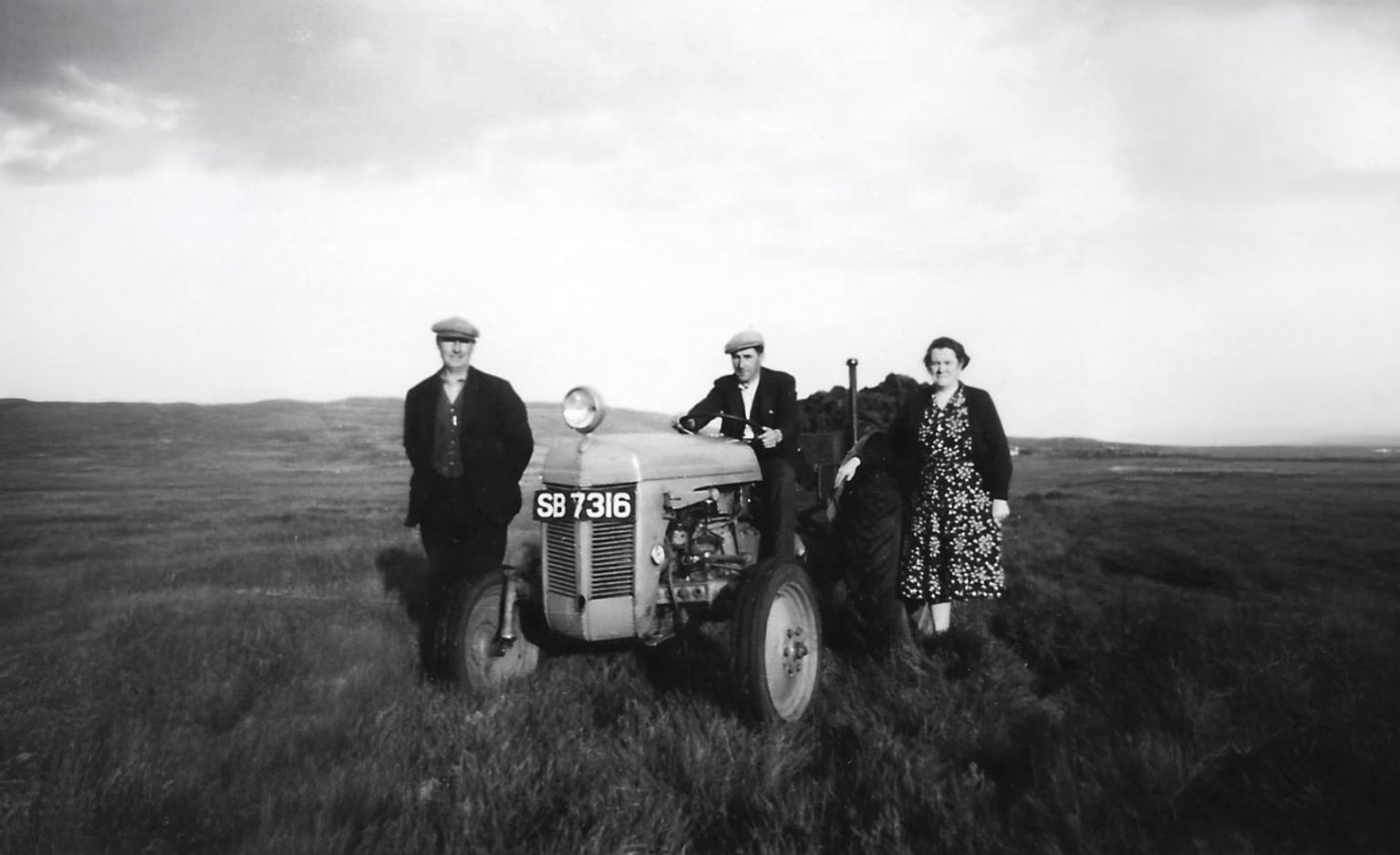
Crofters on Mull
The museum maintains extensive archives documenting all aspects of the island’s history and a large reference library, both of which are available for research purposes. It also houses a significant collection of objects, much of which cannot be displayed simultaneously due to space limitations.
Admission to the Mull Museum is free of charge. However, as the museum is entirely independent and staffed by dedicated volunteers, it relies entirely on donations for its operation and sustainability. Visitors are encouraged to contribute what they can to support this valuable community effort.
The museum is open from 10:00 AM to 4:00 PM, Monday to Saturday, typically from Easter until the end of October. Occasional Sunday openings may also occur during this period. Arrangements can be made for group and school visits outside of these regular opening hours. The museum’s reliance on volunteers and donations highlights its role as a grassroots initiative, deeply embedded in the local community, and dependent on public support to continue preserving and sharing Mull’s heritage.
9. Explore Lip na Cloiche Garden & Nursery: A Horticultural Haven
Lip na Cloiche Garden & Nursery is a small, densely-planted garden on the Isle of Mull, welcoming visitors to explore its horticultural delights. The garden has gained recognition, even being featured on the front cover and in a 12-page spread of the book “Island Gardens” by Jackie Bennet.
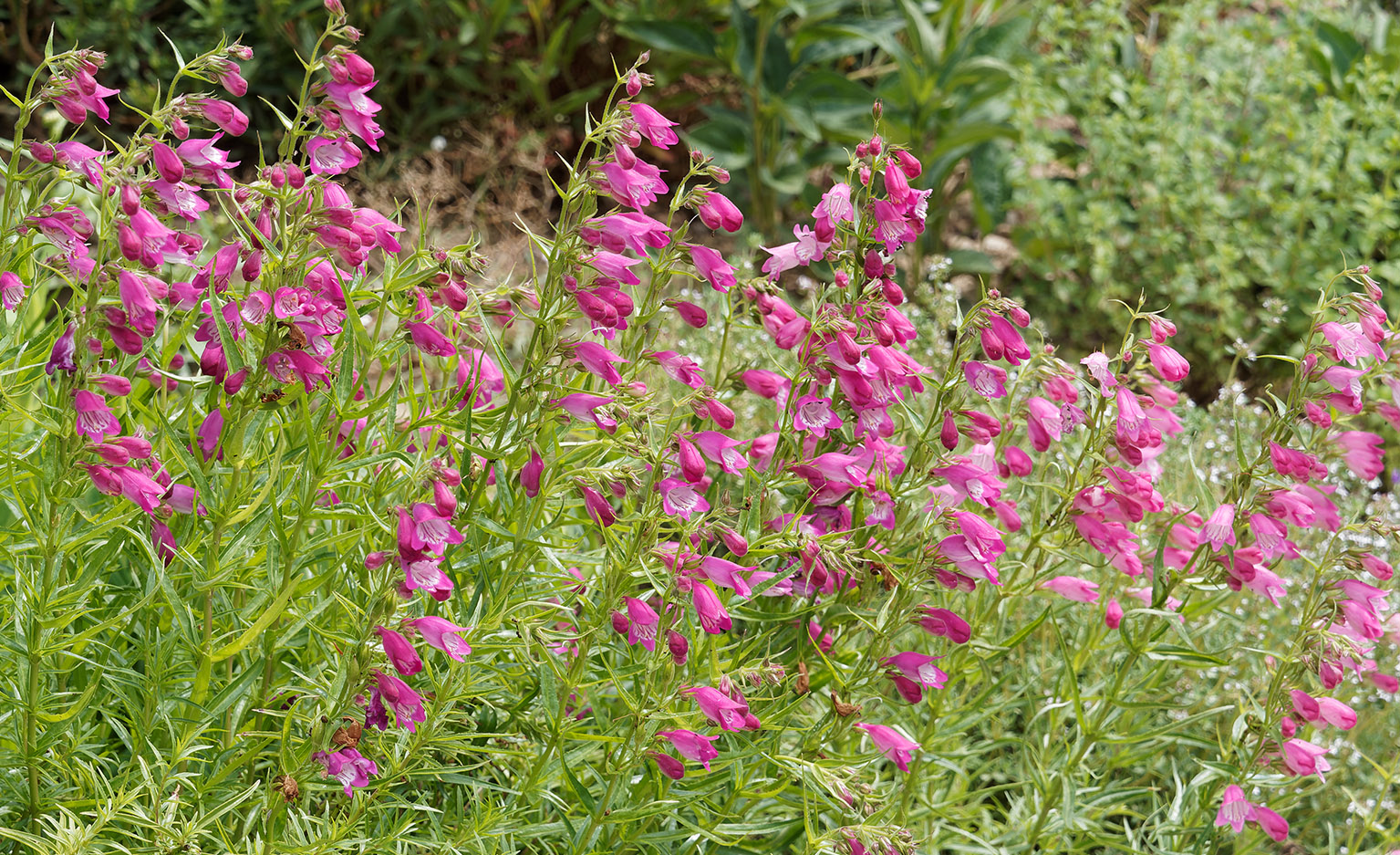
Penstemon Rose Quartz
There is no official admission charge to visit Lip na Cloiche Garden. However, visitors are encouraged to make a donation if they wish to support the garden. A notable aspect of this donation policy is its charitable contribution: 25% of all money raised through donations is allocated to local charities. The garden is open year-round, from dawn to dusk, allowing flexibility for visitors. Additionally, a special Charity Opening Day is held annually, featuring teas and home baking, with all proceeds dedicated to local charitable causes, such as the Isle of Mull Riding for Disabled. This strong emphasis on community contribution through visitor donations underscores the garden’s role as more than just a scenic attraction, but also a significant local philanthropic endeavor.
10. Visit Lochbuie Stone Circle: Ancient Standing Stones
The Lochbuie Stone Circle is an ancient and intriguing site located on the Isle of Mull, near the area of Lochbuie. To access the circle, visitors should drive along the Lochbuie road until Ben Buie comes into view and the road widens to cross a stone bridge. Parking is available at this bridge.
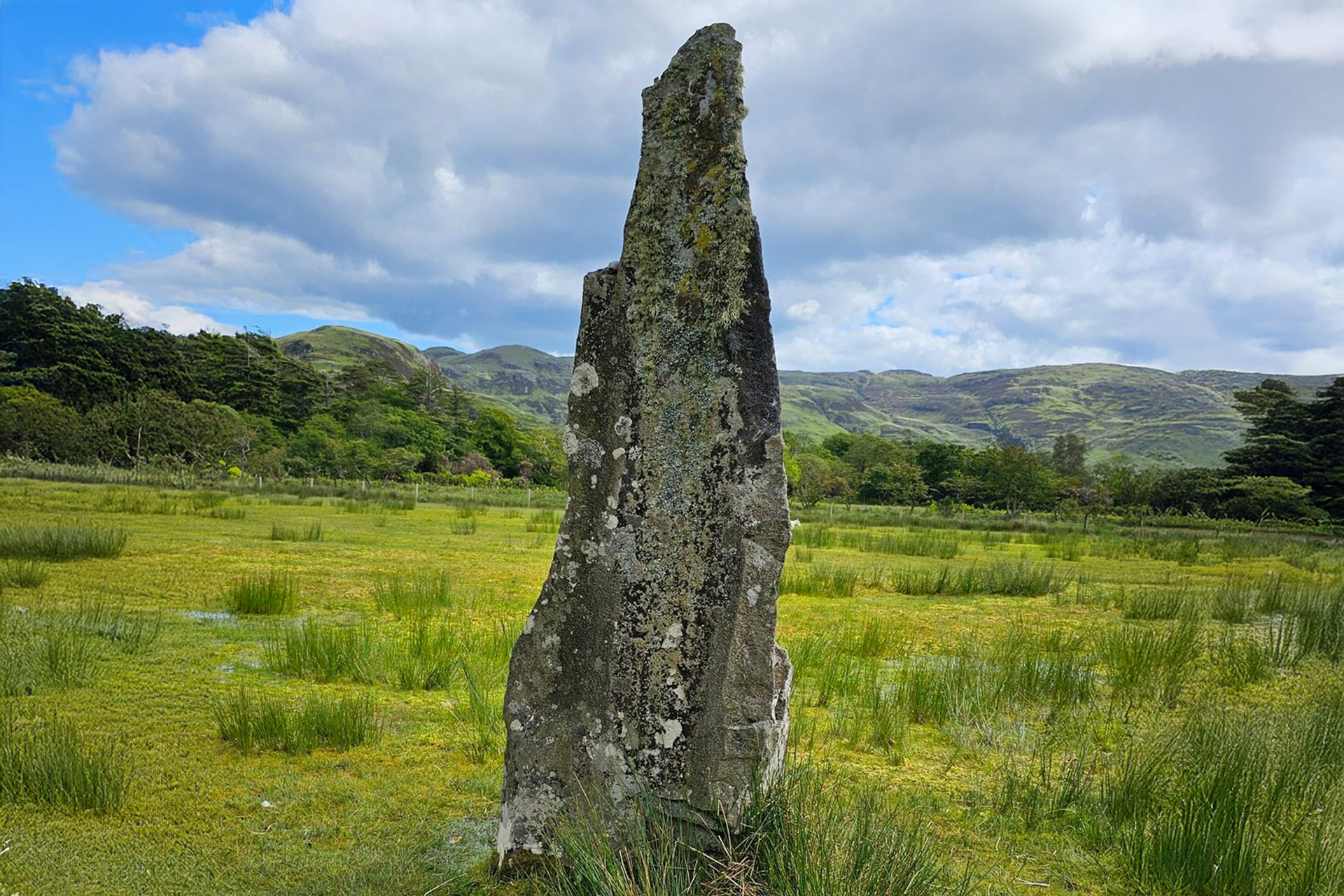
One of the Lochbuie outliers—this 3-metre monolith stands southwest of the circle, aligned with the winter solstice sunset.
The circle originally comprised nine granite stones, arranged in a diameter of approximately 12 meters (about 39 feet). The tallest of these stones reaches about 2 meters (approximately 6.5 feet) in height. The stones are primarily granite slabs, carefully positioned with their flatter faces oriented towards the inside of the circle. One of the original stones has been replaced in recent times with a low boulder. In addition to the main circle, three single outlying stones are situated in the surrounding field at varying distances: one is 5 meters to the south-east and 1 meter tall; another is a striking 3-meter high monolith about 40 meters to the south-west; and the third, over 2 meters high, is located 107 meters to the south-west.
Access to the stone circle is free. From the parking spot at the bridge, visitors must traverse a field towards a wood on the right. This field can be very boggy, especially after rain, but white stepping stones are provided to assist with the crossing. Along the path, visitors may encounter friendly Highland cows and browsing fallow deer, highlighting the site’s integration with local agriculture and wildlife. Upon entering the field through a gate, the stone circle becomes visible at the far end.
While the specific historical context of the Lochbuie Stone Circle is not extensively detailed in the available information, it is briefly noted as “perhaps aligned on the midwinter sunset” through its tallest outlier, suggesting a potential astronomical significance. Visitors should wear appropriate footwear due to the potentially boggy terrain and be mindful of livestock and wildlife, respecting the natural environment during their visit.
11. Calgary Art in Nature: Where Art Meets the Wild
Calgary Art in Nature, also known as the Calgary Art Gallery and Gift Shop, is a family-run establishment located approximately 800 meters from Calgary Bay on the Isle of Mull. This unique venue seamlessly blends artistic expression with the natural environment.
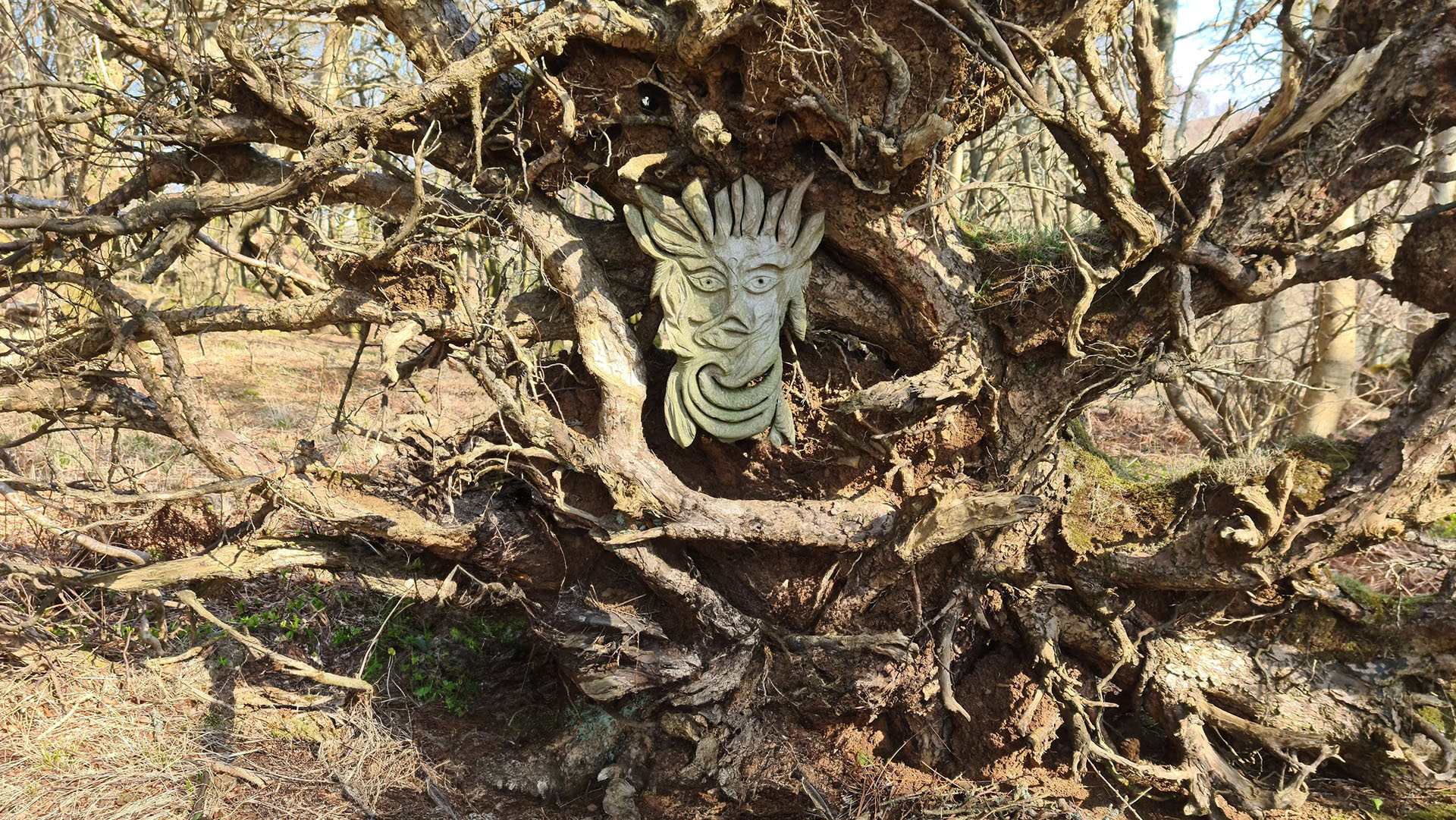
The gallery showcases an ever-changing collection of artworks by over 30 local artists, encompassing a diverse range of mediums including watercolor, oil and acrylic paintings, printmaking, wood carvings, tin sculptures, shell art, ceramics, wood turning, and hand-woven baskets. A gift shop is also available, offering a selection of cards, art prints, tea towels, handmade candles and soaps, and locally made jewelry and textiles. During the winter months, the gallery operates a self-serve café, providing hot drinks and snacks.
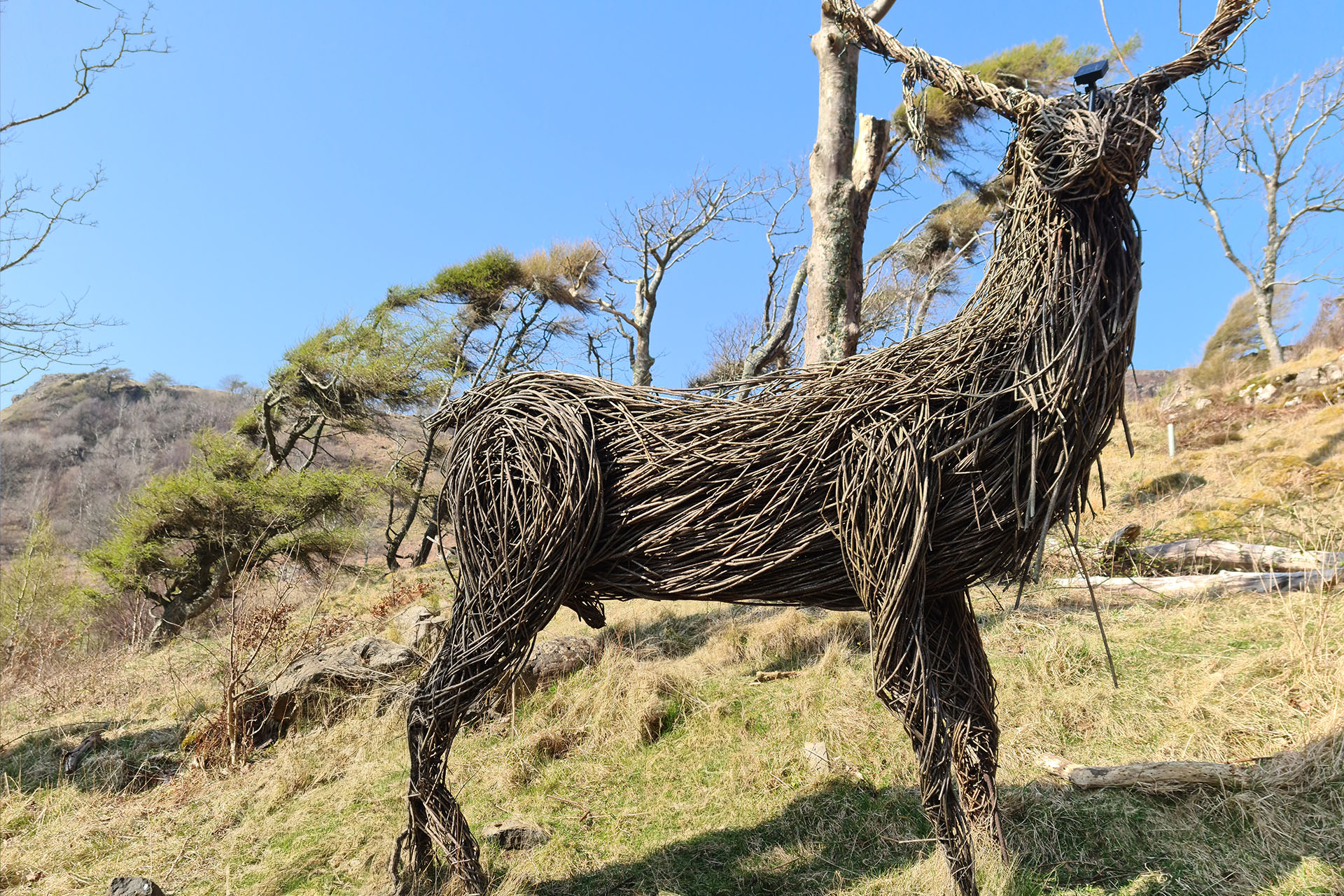
The gallery is nestled within a serene woodland setting and serves as both the starting and ending point for the Calgary Art in Nature woodland walk, which functions as a sculpture trail. Further information and a map of the sculpture walk can be obtained from the gallery staff.
Costs and Opening Hours:
- Entrance to the gallery is free of charge. There is a charge for the Sculpture Walk, priced at £2.50 per adult, with children admitted free.
- Gallery: Open Tuesday to Sunday.
- Weekday hours: 10:30 AM – 4:30 PM
- Weekend hours: 11:00 AM – 4:00 PM
- Closed on Mondays and for a longer period from January to March.
- Sculpture Walk: Open seven days a week.
Accessibility:
- The ground floor of the gallery is accessible to visitors. However, there are steps leading to the upper gallery.
- The main path of the Art in Nature sculpture walk is generally accessible, but it can become rough and steep as it approaches the beach.
- Visitors can view 12 of the sculptures along the main path without encountering steps or significant inclines.
This integration of art within a natural, accessible landscape provides a distinctive and engaging experience for a wide range of visitors.
12. Visit the Isle of Erraid: A Remote Retreat
The Isle of Erraid is a small, tidal island located in the Inner Hebrides, situated off the west coast of Mull and offering views across to the Isle of Iona. This one-square-mile island is home to a small community that lives in harmony with nature, maintaining the island’s buildings and hosting short-term participants in their unique lifestyle.
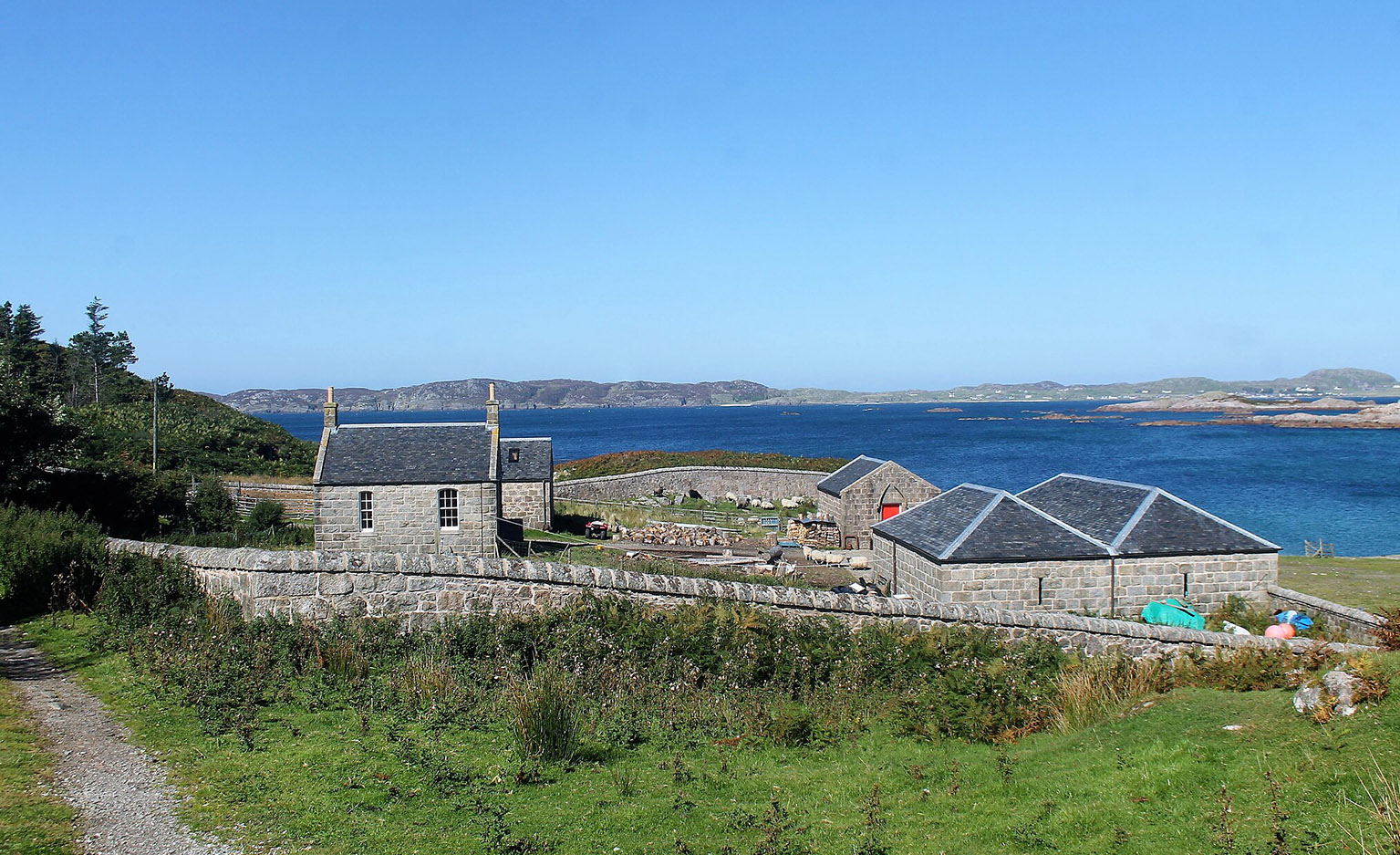
Erraid Farm by Andrew Wood, CC BY-SA 2.0, via Wikimedia Commons.
Access to Erraid:
Erraid is a tidal island, meaning its accessibility is dependent on the tides. Walking access to Erraid from Knockvologan is possible, but visitors must carefully check tide times. It is generally considered safe to cross the tidal causeway up to two hours on either side of high tide. If there is any doubt about the safety of crossing, visitors are strongly advised to contact the Erraid community directly. The island is not accessible by car, but parking is available close to the island at Knockvologan. For those participating in organized programs, a meeting point is typically set at the bus stop in Fionnphort, with specific times for summer and winter seasons.
Activities for Casual Visitors:
- The Lighthouse Observatory on Erraid serves as a unique shop where visitors can purchase handmade rainbow pillar candles, which have been produced by the Erraid Community for over 30 years. These candles are available through an honesty box within the historic Observatory, which itself has historical significance as the former land station for keepers of the Dubh Artach and Skerryvore lighthouses.
- Beyond the Observatory, the island offers opportunities for natural exploration at no direct cost. Visitors can engage in walking, with two primary paths: a shaded walk that covers about half the island in approximately 45 minutes, and a more adventurous 2.5-hour walk around the island’s fringe beach.
- The clear, warm waters around Erraid provide an amazing experience for snorkeling, with reefs and larger formations for the more courageous.
- Beachcombing is also a popular activity, with opportunities to find unique shells.
- For relaxation, visitors can enjoy sunbathing on the white sands.
- A small shop on Erraid sells snacks, postcards, gifts, books, and toiletries.
The critical dependence on tide times for safe access to Erraid underscores the importance of careful planning for any visit. This unique aspect of the island, coupled with its community ethos focused on living in harmony with nature, offers a distinct and tranquil experience for those seeking a remote and reflective retreat. Visitors should be aware that pets are generally not allowed, except for service animals, due to the presence of various farm and wild animals.
13. Visit Fidden Beach: Idyllic Coastal Retreat
Fidden Beach is a picturesque coastal gem located on the Isle of Mull, forming part of the Fidden Farm Campsite. The campsite itself is a family-run establishment, nestled along a safe and secluded bay, offering breathtaking views of the coastline. Its proximity, just one mile from the departure points for popular Isle of Iona and Staffa boat trips, makes it a convenient base for exploring the wider area.
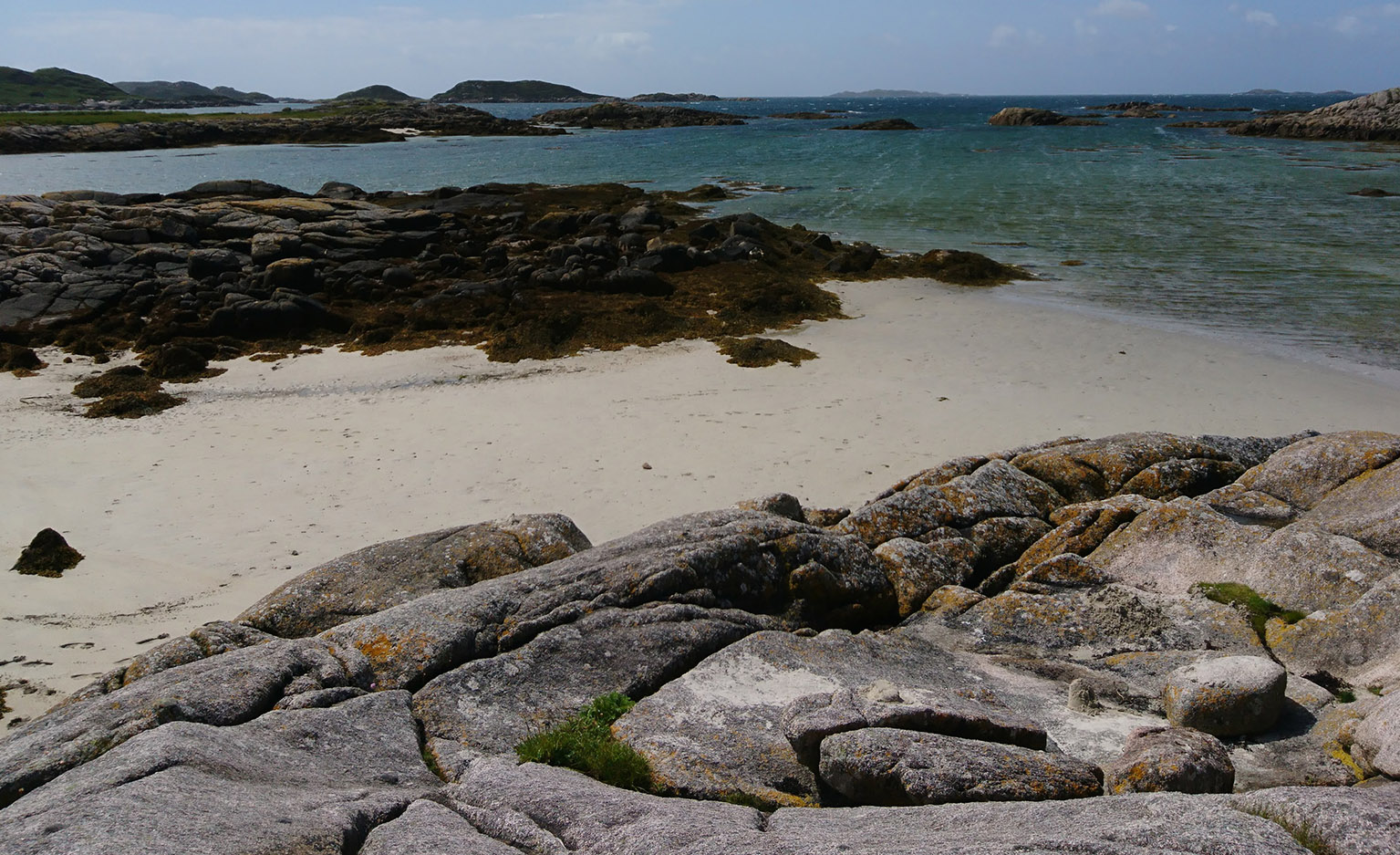
Fidden Beach Fionnphort
The beach itself is characterized by idyllic white sandy shores and shallow, clear waters, making it an excellent spot for various activities. It is particularly loved by children, who can spend endless hours exploring the numerous rock pools. The calm, shallow waters are also ideal for swimming and paddleboarding. Visitors may also be fortunate enough to catch glimpses of various wildlife along the coastline.
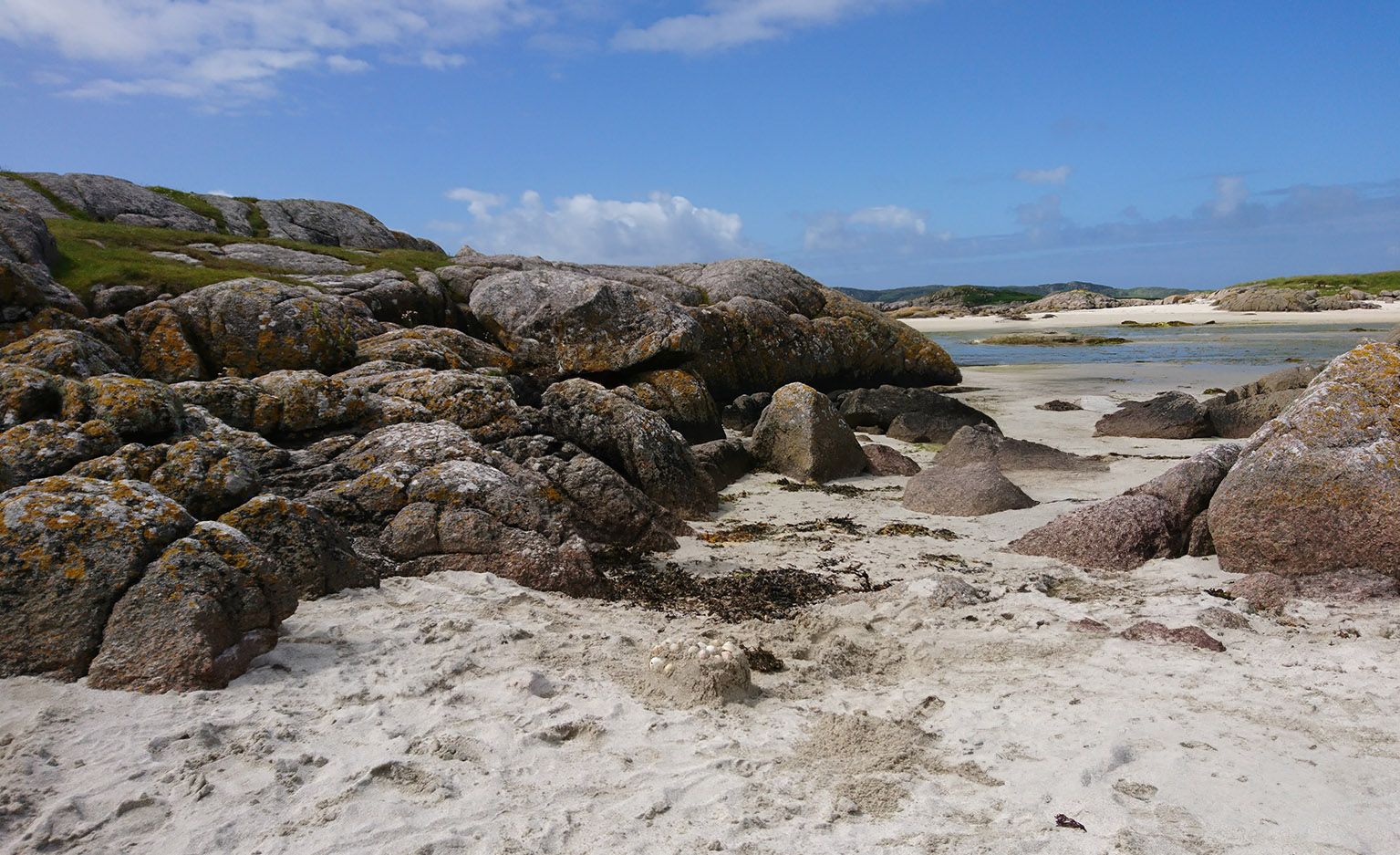
A beach to explore!
Access to Fidden Beach itself is free. For those utilizing the Fidden Farm Campsite, a range of facilities are available, including “luxury loos,” showers, and dishwashing areas. The campsite is dog-friendly, provided pets are kept on a lead. Tents, campervans, caravans, and motorhomes are all welcome, and the campsite operates on a no-booking-needed basis, with reception open from 8 AM to 10 PM for arrivals. The combination of a safe, family-friendly beach with convenient facilities and proximity to other island attractions positions Fidden Beach as an ideal location for a relaxing coastal experience on Mull.
14. Take a Boat Trip to Staffa (includes Fingal’s Cave, Puffins, Basalt Columns)
A boat trip to the Isle of Staffa offers an unforgettable encounter with one of Scotland’s most iconic natural wonders, renowned for its unique geological formations and vibrant seabird colonies. Tours typically depart from Fionnphort or Iona on Mull, with some operators also offering departures from Oban.
Cost and Duration:
Prices for Staffa tours generally start at £40 per adult, with children (5-15 years old) costing £20, and children under 5 traveling free. Some extended tours, such as the Iona and Staffa tour from Mull offered by Turus Mara, are priced at £80 per adult and £40 per child under 16. The duration of the Staffa-focused tours is approximately three hours. The longer Iona and Staffa tours, however, can last from 10:00 AM to 5:30 PM, including over three hours ashore on Iona and one hour on Staffa.
What to See:
- Fingal’s Cave and Clamshell Cave: Staffa is famous for its awe-inspiring hexagonal basalt pillars, which form the dramatic structure of Fingal’s Cave and Clamshell Cave. If weather conditions permit, visitors can land on Staffa and explore these natural wonders. The approach by sea is particularly breathtaking, with the large basalt columns flanking the deep caves. These caves are best viewed by morning light.
- Puffins: A significant highlight for many visitors is the large colony of puffins that breed on Staffa each summer. These distinctive birds, with their colorful beaks during breeding season, can be seen congregating on the cliffs, diving for fish, and returning with beaks full of prey. The best time to observe puffins is during their breeding season, typically between the beginning of May and the end of July or early August, when they are most active and tolerant of human presence, allowing for close viewing and photography.
- Basalt Columns: The entire Isle of Staffa is characterized by its remarkable hexagonal basalt pillars, a result of ancient volcanic activity.
- Marine Wildlife: During the boat journey to and from Staffa, there are excellent opportunities for marine wildlife watching. Common seals are frequently sighted on most trips. Porpoises and dolphins are regularly encountered, with the Sound of Iona being a known “hotspot” for curious bottlenose dolphins. Minke whales and basking sharks are typically seen when the water is warmest, from June to August. Lucky visitors might also spot an otter or even Orca. Other seabirds commonly observed from the boat include shags, oystercatchers, black guillemots, guillemots, razorbills, fulmars, kittiwakes, shearwaters, gannets, and great skuas.
Seasonality and Important Notes:
- Boat trips to Staffa generally operate from April 1st to late October.
- The best times for specific wildlife viewing are seasonal; for instance, puffins are most prevalent from May to August, while whales and basking sharks are more common in June, July, and August.
- It is important to be aware that due to essential maintenance work on Staffa Island, tours may not be able to land on the island from mid to late September.
Visitors should check with tour operators for the most current information regarding landings. The variability in tour options, including different durations and price points, allows visitors to select an experience that best fits their budget and desired level of exploration.
15. Explore Carsaig Arches and Caves: A Challenging Coastal Trek
The Carsaig Arches and Caves, situated at the base of the Rudha Fhaoilean Cliffs on Mull, are a testament to nature’s erosive power, featuring naturally arched cliff formations and nearby caves. This destination offers a spectacular, albeit demanding, coastal trek.
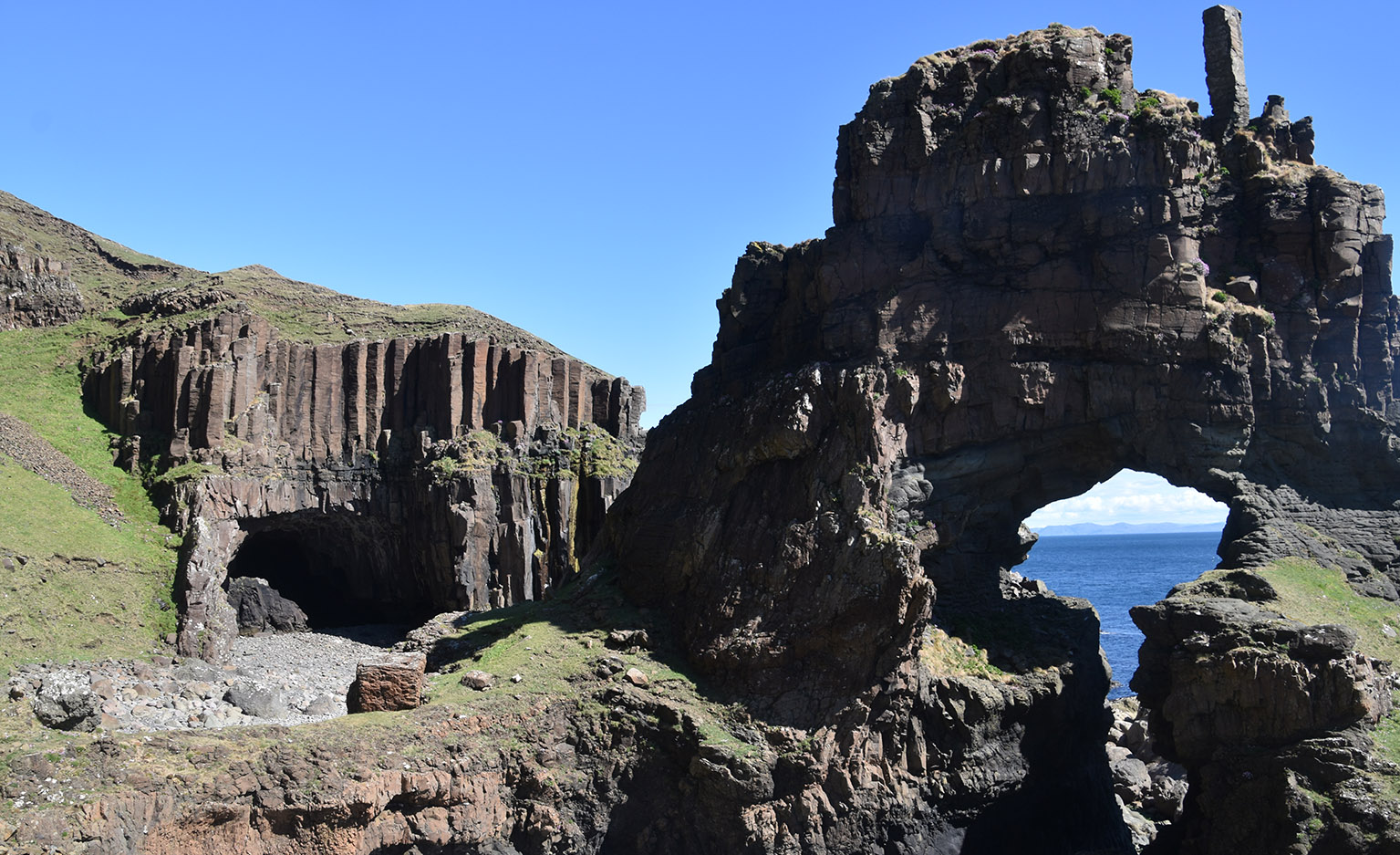
Carsaig Arches by Jonathan Long, CC BY-SA 2.0, via Wikimedia Commons
Difficulty and Terrain:
The hike to Carsaig Arches and Caves is graded as “Hard,” covering a distance of 8 miles and requiring an estimated 6 hours to complete. The terrain is exceptionally challenging, characterized by rocky, narrow cliff paths with “vertiginous drops”—steep, dizzying descents—and very uneven ground that often requires clambering over boulders. The path can be indistinct in places, alternating between narrow cliff tracks and boulder-strewn sections at the top of the beach.
A critical safety warning accompanies this trek: it is strongly advised not to attempt this walk alone or if one has a fear of heights, as a single slip could potentially be fatal.
Route Details:
The journey begins by parking at Carsaig Pier, which is accessed via a minor road off the A849 at Pennyghael. Parking space is limited to only four or five vehicles, so an early start is recommended. From the pier, the track heads west along the top of the beach. At a fork, visitors should bear left and pass through a gap between a wall and a gate. Upon reaching a second gate, it is advised not to cross the stile but instead to continue along the beach, as this route makes it easier to navigate two burns (small streams) that need to be forded closer to the shore. After crossing the burns, the path continues at the top of the beach, which can be muddy, though planks of wood are often strategically placed by previous walkers to assist.
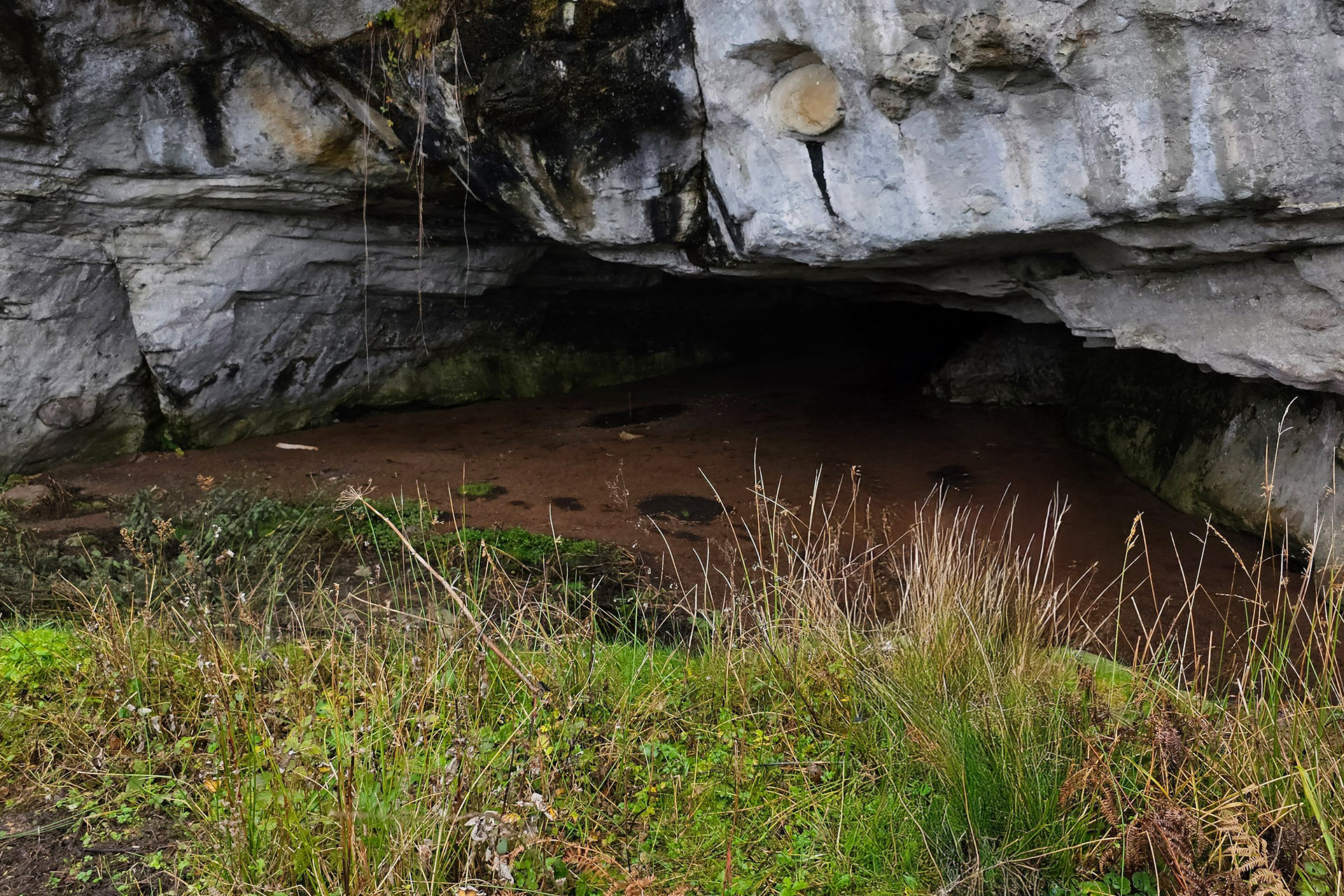
The Nuns Cave
After approximately one hour of walking, the Nun’s Cave is reached. This shallow cave features sandstone topped with basalt columns. Historically, it is believed that nuns sought refuge here after fleeing Iona Abbey during the Reformation. The cave contains religious carvings, thought to date back to the 6th century, as well as marks made by stone masons who used the cave to prepare stone for Iona Abbey. Unfortunately, modern graffiti is also present.
Beyond the Nun’s Cave, the terrain becomes “slightly easier,” but it is still a significant one and a half to two-hour walk to reach the Carsaig Arches. Once the first arch is reached, those with a “good head for heights” may choose to clamber up a narrow goat track and walk over the first arch, descending a “fairly treacherous path” to the second arch. This path over the arch is narrow and exposed and should not be attempted in bad weather or by inexperienced walkers. Once on the beach below, it is possible to stand directly under both arches, which are in fact sea caves that have been completely eroded through. The return journey follows the exact same challenging route.
Access to the Carsaig Arches and Caves is free. This trek offers a profound encounter with Mull’s dramatic geology and a glimpse into its historical past, but it demands serious preparation, appropriate gear, and a high level of caution due to its inherent dangers.
16. Visit Aros Park: Nature and Recreation in Tobermory
Aros Park, conveniently located within walking distance of Tobermory, is a delightful woodland area on the Isle of Mull that offers a variety of recreational opportunities for visitors of all ages.
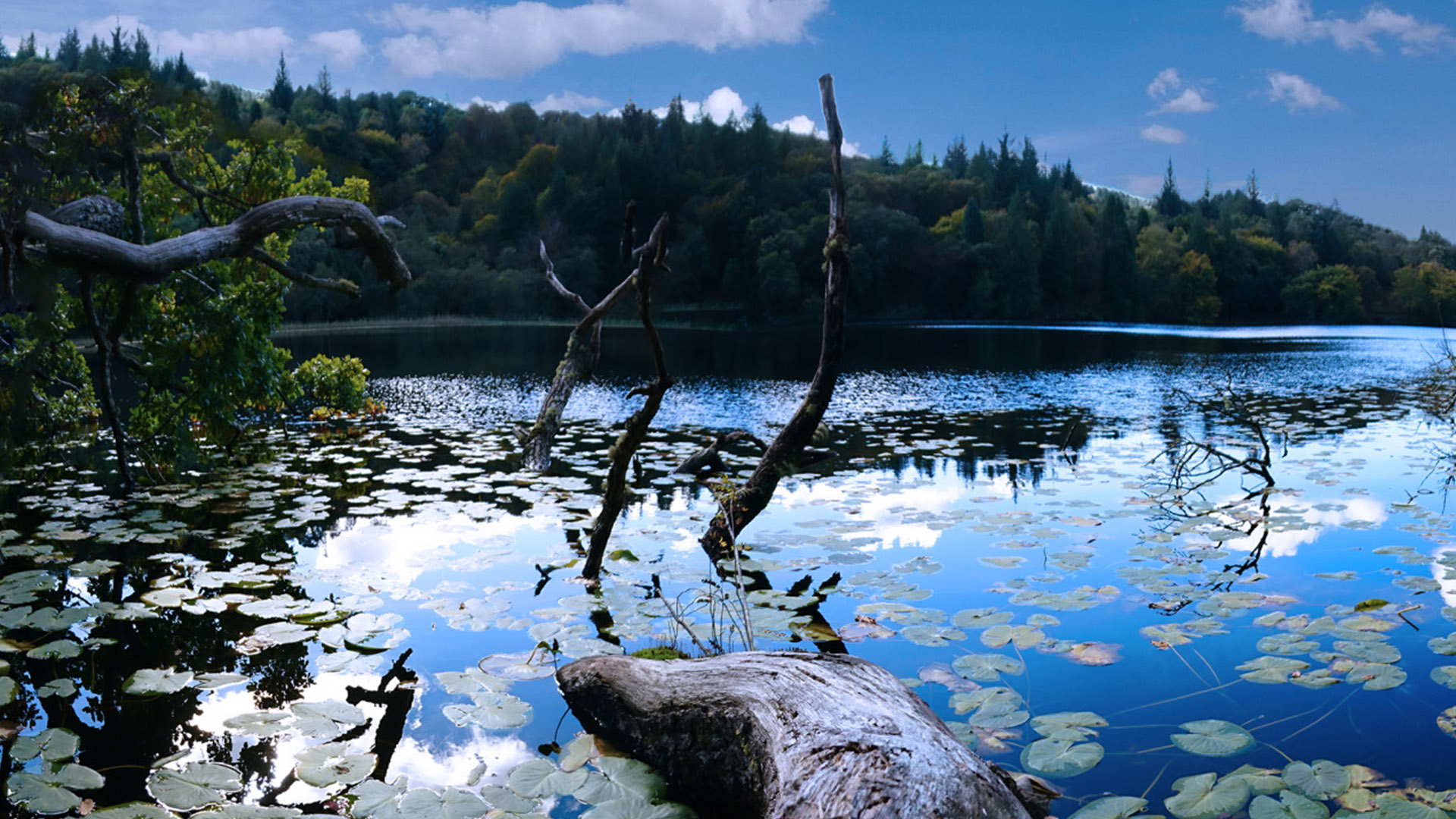
Aros Park artificial loch Lochan a Ghurrabain.
The park features charming circular routes through its woodlands, providing a peaceful environment for walks. For those seeking more vigorous activity, a longer trek to Loch Frisa is available, which is particularly well-suited for cyclists but also welcomes adventurous walkers and horse riders. Within the park, an historic graveyard is hidden among the trees, offering a quiet place for reflection and a glimpse into the area’s past.
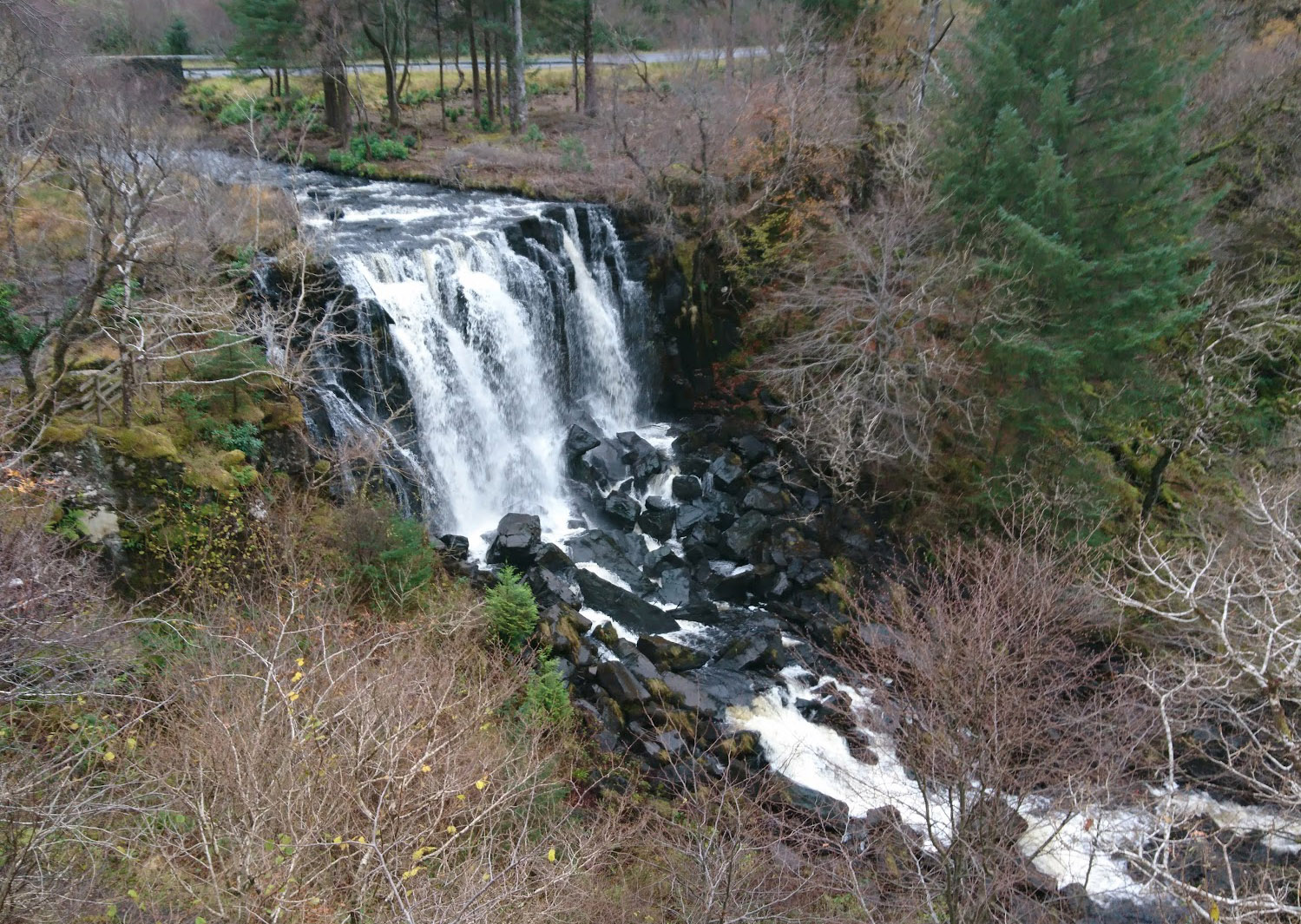
Aros Park is designed with accessibility in mind, offering easy-access facilities. It is a particularly family-friendly destination, boasting rustic playground equipment and a lovely fishing lochan stocked with rainbow trout. Fishing licenses for children are inexpensive and can be purchased at Brown’s Ironmongers in Tobermory. A play park is also located at the top of the hill, past the Western Isles Hotel. Additionally, the park provides barbeque facilities, making it an ideal spot for outdoor gatherings. The park’s setting offers picturesque views towards scenic Tobermory, with ferns and waterfalls adding to its natural beauty.
Access to Aros Park is free of charge. Its combination of recreational amenities, natural beauty, and historical elements, all within easy reach of Tobermory, makes it a versatile and enjoyable destination for both residents and visitors. The park’s commitment to providing activities for different age groups and ensuring accessibility for many highlights its role as a valuable community and tourist asset.
17. Explore Ardura Forest: A Living Ecosystem and Community Hub
Ardura Community Forest, known in Gaelic as Doir a’ Chuilinn, or ‘holly grove,’ is a site of profound historical and ecological significance on the Isle of Mull. The forest’s history stretches back to medieval times, with its oldest known tree, a holly, dating to around 1733, making it approximately 300 years old. For centuries, Ardura was integral to the lives of Mull families, serving as grazing and shelter for animals during market journeys and seasonal storms, and providing timber and firewood for sustenance.
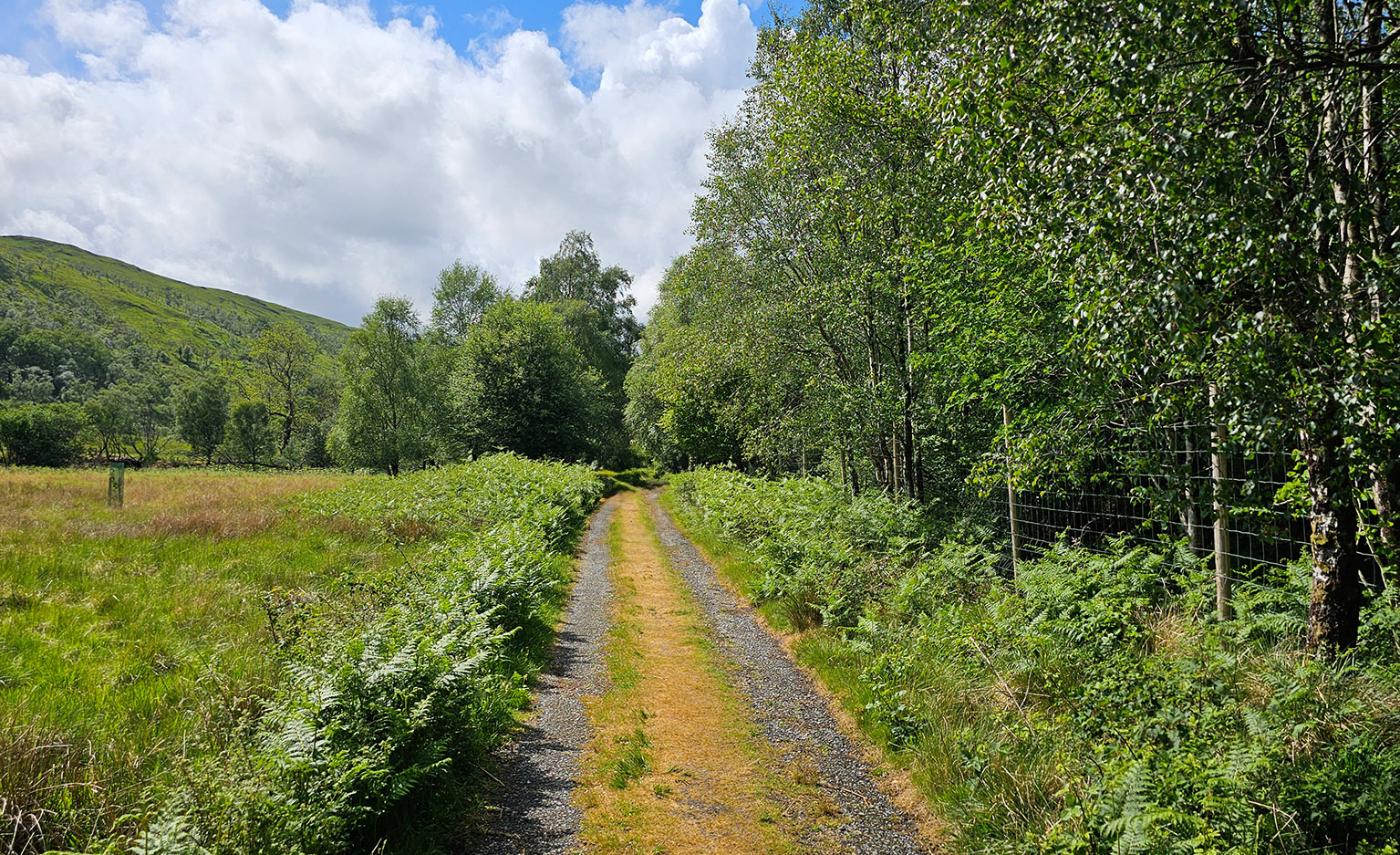
Short walk to Ardura
Today, Ardura Forest is cherished by islanders and visitors alike as a place for gentle recreation, experiencing nature, finding solace, and reflecting on cultural and personal connections to past generations. In a remote community with limited indoor leisure facilities, the forest provides a crucial outdoor space for meeting, socializing, and for children and families to play and learn together, fostering well-being and reducing loneliness.
Ecologically, Ardura is an ancient oakwood and a vital part of the Atlantic rainforest, recognized as one of Scotland’s most precious and globally rare habitats, comparable in importance to tropical rainforests. This unique environment supports a rich and diverse array of birds, mammals, and plants, including marsh fritillary butterflies, pine martens, the very rare hazel glove fungus, redstarts, spotted flycatchers, iconic birds of prey like eagles and hen harriers, and even the elusive otter.
Access to Ardura Forest is free. Visitors can enjoy various walks, such as the Ardmore Walk, an easy-graded 4-mile, 2-hour forestry track and shore excursion. This walk offers beautiful views towards Coll and Ardnamurchan, passes a ruined settlement, and leads to a bird hide in Ardmore Bay, an excellent spot for shelter and observing seals and seabirds. The path also features stunning views across the Sound of Mull and passes the ruins of the old school at the hamlet of Ardmore.
The forest is now under community ownership, stewarded by the Mull and Iona Community Trust. The community is actively engaged in restoring and protecting this ancient rainforest, addressing damage from past commercial tree planting and harvesting, and overgrazing by wild deer. These efforts aim to conserve globally rare species and support vulnerable wildlife, while also creating local employment and preserving cultural connections. This long-term vision seeks to regenerate, protect, and enhance Ardura’s biodiversity for future generations. The community’s proactive approach to conservation ensures that this special place continues to thrive as both a natural sanctuary and a communal resource.
18. Visit Glengorm Castle & Estate: A Highland Experience
Glengorm Castle, a Category-B Listed Building, stands on the north coast of the Isle of Mull, approximately 4 miles from Tobermory. Built in 1860 in the Scottish baronial style, the castle commands breathtaking views over the Atlantic Ocean, stretching out to the Outer Hebrides and the islands of Uist, Rum, and Canna.
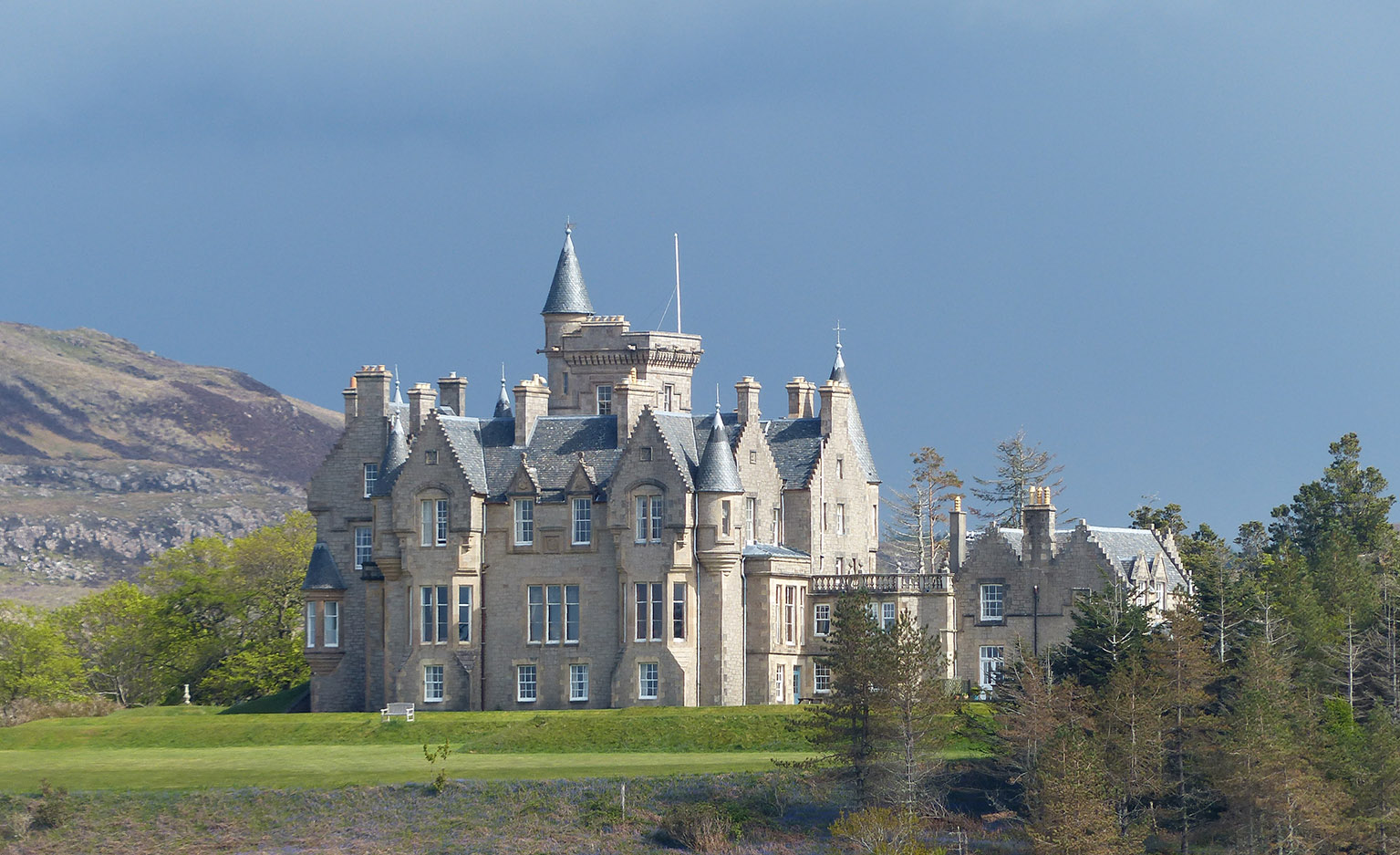
Kognos, CC BY-SA 4.0, via Wikimedia Commons
While Glengorm Castle primarily operates as a hotel offering self-catering and B&B apartments and cottages, it is generally not open to the public for casual entry as a visitor attraction. Accommodation rates for staying at the castle can range from an average of £540 per weeknight to £615.
However, the estate does offer specific opportunities for public engagement:
- Castle Tours: Guided tours of Glengorm Castle are available, typically running every Wednesday at 11:15 AM, with additional dates during the summer and flexible bookings for groups. These tours, which cost £10 per adult (children are free), provide a chance to explore centuries of history within an hour, including access to the estate grounds, walled garden, woodland walk (after March 2025), and specific castle rooms such as the main hall, reception room, dining room, and “blue room”.
- Wildlife Watching Tours: Guided wildlife watch tours are also offered on the Glengorm Castle estate, with costs starting from $20-$21 per person.
- Public Facilities: A coffee shop and farm shop are open to the public from April to October.
- Estate Walks: The vast estate offers excellent walking opportunities with panoramic views of the castle and surrounding landscapes. One particular walk leads to the old fort of Dun Ara Castle. Free parking is available for visitors to the estate.
It is important for visitors to distinguish between the castle as a private hotel and the specific public access opportunities available for tours, shops, and walks. This allows for a planned visit that respects the primary function of the property while still enjoying its historical grandeur and natural surroundings.
19. Visit the Tobermory Distillery (for tours/tasting): A Taste of Mull
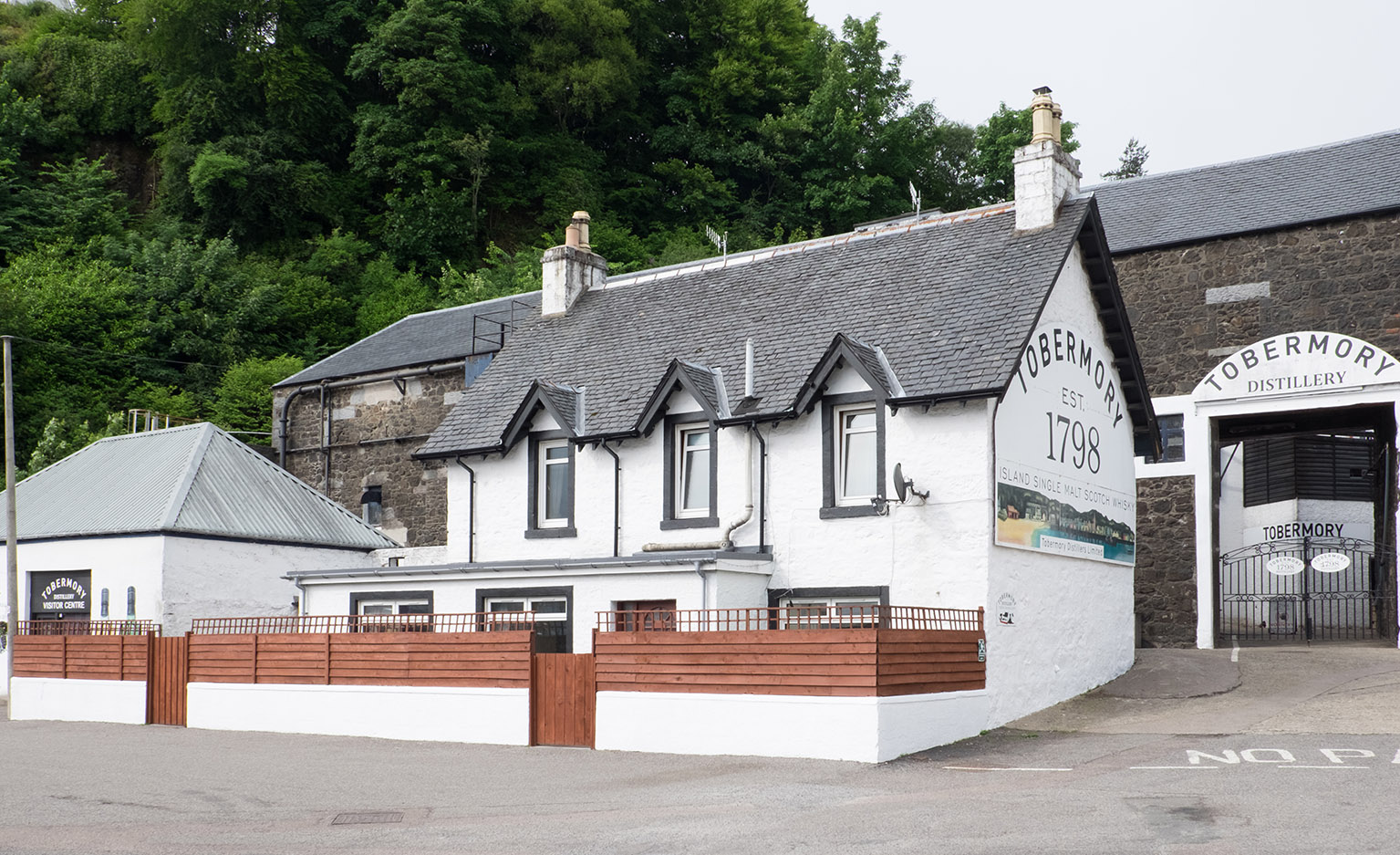
DeFacto, CC BY-SA 4.0, via Wikimedia Commons
Tobermory Distillery, located in the vibrant town of Tobermory on Mull, offers visitors an opportunity to delve into the world of Scotch whisky and, more recently, gin production.
Tours and Tastings:
- Standard Tour: A 45-minute tour, priced at £18.50, includes a tasting of two drams—one peated and one non-peated expression of their whisky.
- “Warehouse No.1” Tour: For a more in-depth experience, this tour costs £50 and features a tasting session of four of the distillery’s prestigious single malt expressions.
- Gin Tasting: Since 2022, the distillery has offered a Gin Tasting experience for £18, allowing visitors to sample four different gin recipes.
All tours include a £5 voucher that can be used towards a bottle or gift purchase from the Distillery shop. Children under 9 years of age are not permitted on the tours.
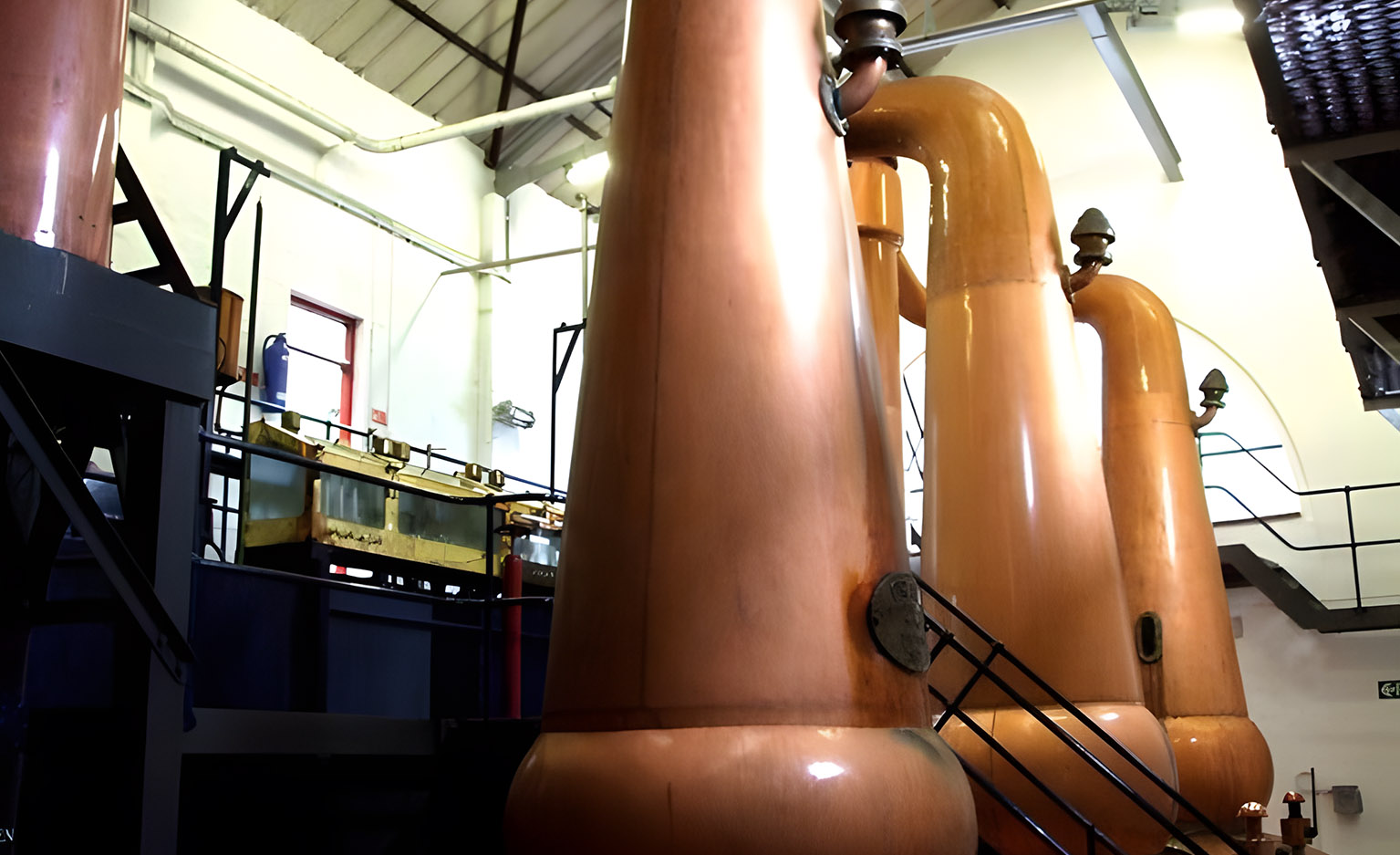
Rob Farrow / Stills, Tobermory Distillery
Opening Hours and Facilities:
The distillery’s shop is open year-round, from Monday to Sunday, between 11:00 AM and 4:00 PM. Parking is available on-site. While there is no cafe or restaurant directly within the distillery, Tobermory offers numerous dining options nearby. The availability of various tour and tasting options caters to different levels of interest, from a quick introduction to a deeper appreciation of the distillery’s spirits, making it a key attraction for those interested in local produce and craftsmanship.
Isle of Iona: Spiritual Sanctuary and Natural Beauty
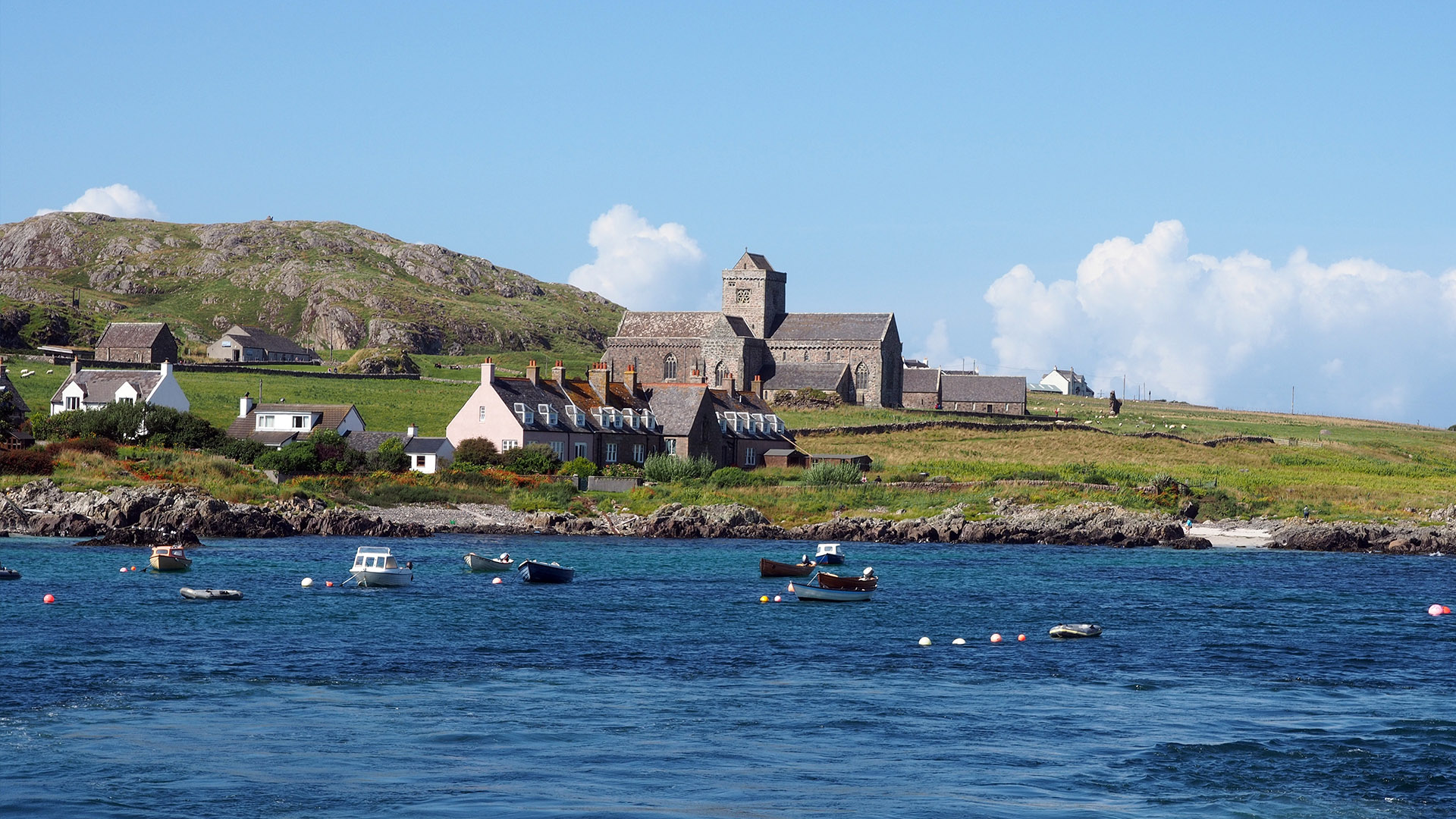
The Isle of Iona, though often associated with Mull due to its ferry connection, stands as a distinct spiritual sanctuary and a haven of natural beauty.
20. Visit Iona Abbey and Nunnery: A Beacon of Christianity
Iona Abbey and Nunnery represents one of Scotland’s most sacred sites, a vibrant center of Christian worship since the arrival of St. Columba in AD 563. Despite enduring repeated Viking raids, Columba’s monastery thrived until the late 12th century, after which a Benedictine abbey was founded around 1200 by the sons of Somerled, ‘King of the Isles’. Pilgrimage to St. Columba’s Shrine continued until monastic life ended with the Protestant Reformation in 1560. It is widely believed that the world-famous Book of Kells, a masterpiece of early medieval art, was created here. Today, the Iona Abbey Museum houses Scotland’s finest collection of early medieval carved stones and crosses. The Iona Community, formed in 1938, has revived the abbey’s long tradition of work, worship, and teaching.
Visitor Experience:
- Immerse yourself in the special atmosphere of Iona.
- Explore the abbey church, with its architecture spanning the 13th to 16th centuries, restored as an active place of worship.
- See the four iconic high crosses, enduring symbols of Iona’s Christian legacy.
- Stand on Tòrr an Aba, the small hill where St. Columba is said to have had his writing hut.
- Explore St. Oran’s Chapel and Reilig Odhráin, the ancient graveyard believed to be the resting place of early Scottish kings.
- Look for the vallum, a boundary ditch and earth bank, the only remaining evidence of Columba’s original monastery.
- Walk the Street of the Dead, a medieval route flanked by the medieval St. Martin’s Cross and a replica of St. John’s Cross.
- Step inside the nearby Augustinian nunnery, the most complete nunnery complex surviving in Scotland.
- For an enhanced visit, an audio guide is included in the admission price, and a fun fact-finding quiz (also available in Gaelic) helps engage visitors.
Admission Prices (April 1, 2025, to March 31, 2026):
Tickets can be booked online or purchased on-site. Online prices are generally slightly lower for individual adult and concession tickets, while walk-up prices are slightly higher. Family tickets show variations depending on the number of children.
| Ticket Type | Online Price | Walk-up Price |
|---|---|---|
| Adult (16-64yrs) | £10.00 | £11.00 |
| Concession (65yrs+ & unemployed) | £8.00 | £9.00 |
| Child (7-15yrs) | £6.00 | £6.50 |
| Family (1 adult, 2 children) | £20.00 | £21.50 |
| Family (2 adults, 2 children) | £29.00 | £31.50 |
| Family (2 adults, 3 children) | £34.00 | £37.50 |
Note: Historic Scotland members, carers accompanying visitors with disabilities (up to two, online booking recommended), and Young Scot cardholders (£1 entry) may receive free or discounted admission.
Opening Hours:
- April 1 to September 30:
- Monday to Saturday: 9:30 AM to last entry at 4:45 PM (closes 5:30 PM)
- Sunday: 12:30 PM to last entry at 4:45 PM (closes 5:30 PM)
- October 1 to March 31:
- Daily except Sunday: 10:00 AM to last entry at 3:15 PM (closes 4:00 PM)
The abbey may close at short notice due to weather disruption to the ferry service.
Accessibility:
The abbey is located approximately a quarter-mile from the ferry terminal on Iona. Taxis can be arranged for transport. The potential for short-notice closures due to ferry disruptions highlights the island’s reliance on weather-dependent transport, which is a crucial factor for visitors to consider when planning their trip. This dependency underscores the need for flexibility and checking local conditions.
Conclusion: Planning Your Hebridean Exploration
The islands of Mull, Iona, and Staffa collectively offer an extraordinary range of experiences, from dramatic geological formations and ancient historical sites to vibrant wildlife encounters and tranquil natural landscapes. This guide has provided detailed information on twenty key activities, highlighting their locations, associated costs, and essential considerations for planning.
Successful exploration of these Hebridean gems hinges on thoughtful preparation. Factors such as the seasonal availability of wildlife (e.g., puffins on Staffa are best seen from May to July), the tidal nature of access to islands like Erraid, and the specific operating schedules of ferries (e.g., no Saturday ferry to Ulva) are crucial for itinerary development. Furthermore, understanding the nuances of accessibility for historic sites like Duart Castle, which, while offering some provisions, retains inherent structural limitations, allows visitors to manage expectations and plan accordingly. The report underscores the value of local knowledge and guided tours, particularly for challenging hikes like Ben More, where magnetic interference affects navigation, or for maximizing wildlife sightings.
Beyond the practicalities, a recurring theme is the importance of responsible tourism. Whether it is adhering to waste management guidelines at Calgary Bay, respecting the unmanaged dangers of Eas Fors Waterfall, or minimizing disturbance to sensitive wildlife, visitors play a vital role in preserving the pristine beauty and unique character of these islands. The community-driven efforts, such as the volunteer-run Mull Museum and the conservation work in Ardura Forest, highlight a deep local commitment to stewardship that visitors are encouraged to support and respect.
In essence, Mull, Iona, and Staffa promise deep engagement for those who approach their visit with a spirit of inquiry, respect, and careful planning. The diversity of experiences ensures that every traveler can craft a unique and memorable journey through these enchanting Scottish islands.


